Impact of Business Coalition on Agricultural Policy: A Case Study of the Effect of Sugar Indust
The Impact of Doing Business Regulations on Investments in ICT
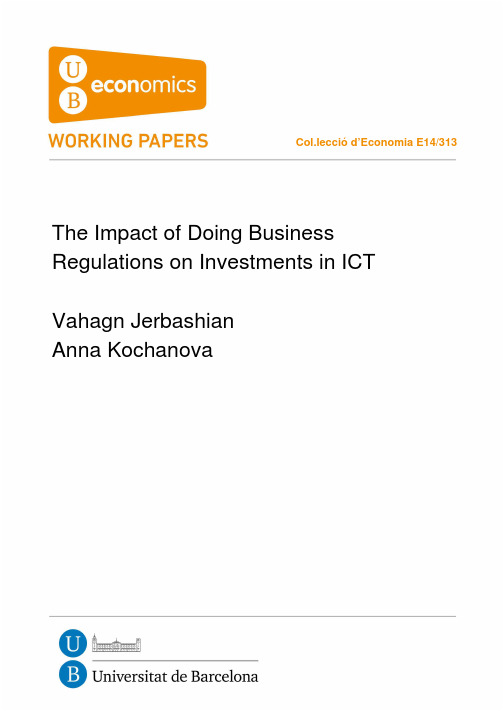
Col.lecció d’Economia E14/313The Impact of Doing Business Regulations on Investments in ICTVahagn JerbashianAnna KochanovaUB Economics Working Papers 2014/313 The Impact of Doing Business Regulations onInvestments in ICTAbstract:Using industry-level data from 14 OECD countries and doing business indicators of the World Bank, we analyze how country-level regulations of business activities affect investments in information and communication technologies (ICT). We find that investments in ICT decrease with the costs of starting and operating a business and registering property. Investments increase with the strength of legal rights. We also find that higher minimum capital requirement reduces investments in software and the extent of director liability reduces investments in communication technologies.JEL Codes: O38, O25, O43, L50.Keywords: Investments in ICT, Regulations of Doing Business.Vahagn JerbashianFacultat d'Economia i EmpresaUniversitat de BarcelonaAnna KochanovaMax Planck Institute for Research onCollective GoodsAcknowledgements: We would like to thank Montserrat Vilalta-Bufi, Xavier Raurich, and Fernando Sanchez-Losada for insightful comments. All errors remain our own.ISSN 1136-8365IntroductionThere is a growing debate whether and how country-level regulations of doing business matter for aggregate performance(e.g.,Klapper,Laeven,and Rajan,2006;Djankov, McLiesh,and Ramalho,2006;Barseghyan,2008;Fisman and Allende,2010;Branstetter, Lima,Taylor,and Venncio,2013).In turn,empirical evidence suggests that one of the significant drivers behind recent improvements in aggregate performance are investments in information and communication technologies(ICT)(e.g.,R¨o ller and Waverman,2001; Czernich,Falck,Kretschmer,and Woessmann,2011;Jerbashian and Kochanova,2012; Jorgenson,Ho,and Stiroh,2005).In this paper,we investigate how country-level regulations of business activities af-fect industry-level investments in ICT.In order to alleviate endogeneity concerns,we use a difference-in-differences framework in the spirit of Rajan and Zingales(1998).More specifically,we ask whether ex ante differences in country-level regulations affect invest-ments in ICT differently in industries that depend more on these technologies compared to the industries that depend less.To establish our results,we use industry-and country-level data from14OECD countries and the World Bank’s doing business indicators.In particular,we focus on indicators related to starting business,registering property,get-ting credit,protecting investors,and paying taxes.1Our results suggest that investments in ICT decline with the number of procedures, time,and costs required for starting a business and time required for registering property. Investments in ICT also decline with the number of tax payments and time required for compiling tax payments.In turn,investments increase with the strength of legal rights. We fail to establish any systematic evidence that the monetary costs and number of procedures required for registering property affect investments in ICT.However,wefind that they significantly reduce investments in information technologies(IT).Further,we fail to establish any systematic evidence that minimum(paid-in)capital requirement for starting a business and the extent of director liability for self-dealing affect investments in ICT.Wefind,however,that increasing the minimum required amount of(paid-in)capital reduces investments in software and the extent of director liability reduces investments in communication technologies(CT).Djankov et al.(2006)and Barseghyan(2008),among others,show that the regulations of business activities matter for economic growth.In particular,theyfind that countries with less burdensome regulations grow faster.Given that investments in ICT contribute significantly to economic growth(see,for instance,R¨o ller and Waverman,2001;Jorgenson et al.,2005),ourfindings suggest a possible driver behind the results of such macro-level empirical studies.Moreover,they suggest possible policy instruments which can increase investments in ICT and,therefore,aid and compliment policy agendas such as the Digital 1These indicators are widely used in academia and by policymakers(see for further details Djankov,2009).Agenda in Europe and Europe2020.Primarily,this paper is related to studies which identify the impact of regulations on investments in ICT(e.g.,Gruber and Verboven,2001;Gust and Marquez,2004;Heli and Kretschmer,2005;Andonova,2006;Andonova and Diaz-Serrano,2009;Nardotto,Val-letti,and Verboven,2012;Bauer,Madden,and Morey,2014).It is also related to studies which analyze the impact of policies on investments and,particularly,on investments in intangible assets(e.g.,Barro,1997;Carlin and Mayer,2003;Claessens and Laeven,2003). Typically,these studies focus on particular industries and policies andfind that less red-tape and deregulation encourage investments.This paper contributes to these studies by assessing the impact country-level regulations of doing business on industry-level invest-ments in ICT.There is also a growing number of studies which investigate the impact of institutions and various regulations on economic performance(e.g.,Barone and Cingano, 2011;Caballero,Cowan,Engel,and Micco,2013;Bena,Ondko,and Vourvachaki,2011; Acemoglu,Johnson,and Robinson,2001).This paper contributes to these studies to the extent that one of the pronounced drivers of recent surge in economic performance are the investments in ICT.The next section offers a simple model to motivate the empirical test.The third section offers the empirical specification,and describes the data and its sources.The fourth section summarizes the results.The last section concludes.Theoretical ModelA regulation,which is common to all industries,would penalize(or subsidize)investments in information and communication technologies more in industries which depend more on these technologies.2To show explicitly how such an inference can hold and set the stage for the empirical analysis,we develop a stylized deterministic model which follows the model of Alesina,Ardagna,Nicoletti,and Schiantarelli(2005).We consider an industry where N infinitely livedfirms produce horizontally differ-entiated goods x,indexed by j.For simplicity,let the production function of a good j (∀j=1,...,N)bex j=Akαj l1−αj,(1)where A>0is an exogenous productivity level,k is the amount of ICT capital input, l summarizes all other inputs(e.g.,labor),andα∈(0,1)is output elasticity of ICT capital.In this respect,αmeasures the dependence on that capital since higherαmeans higher output elasticity of ICT capital.Thefirms can invest and accumulate capital with a technology˙k=ι−δk,(2) 2This statement is essentially an analogue of the Rybczynski theorem.where ιis the amount of investment and the initial value of k is given and is the same for all firms.We further assume that firms incur adjustment costs for installing the newly created capital.Adjustment costs are in terms of the firms’output and have the standard quadratic form b 2 ιk2k ,where b >0is adjustment cost parameter.To capture the effect of business regulations on firms’profits in a reduced form,we assume that these regulations affect the revenues and the costs of the firms so that the profits of firm j net of investment costs areπj =(1−τx )p x j x j −wl j −(1+τι)p ιιj −(1+τb )p x j b 2 ιjk j 2k j ,(3)where p x j and p ιare the prices of x j and ιj ,and w is the price of l .In turn,τx ,τι,and τb are the effects of regulations.For example,τx >0can represent business taxes,and τι<0and τb <0can represent regulations which subsidize investments or increase their efficiency (returns on investments).Suppose that firms in this industry are price setters so that they could coup their investments in ICT.Moreover,A grows at a constant rate g A .Denoting interest rate by r and the policy affecting it by τr ,the problem of the firm j ismax p x j ,l j ,ιj V j =+∞0πj (t )e −[(1+τr )r −g A ]t dts.t.(1),(2),(3),where the initial value of A is normalized to 1.For example,τr <0can represent policies which facilitate lending and reduce borrowing costs.Using q to denote the shadow value of investments and focusing on symmetric equi-librium,the necessary conditions for optimality are given byw =(1−α)(1−τx ) 1−1e x l ,(4)q =(1+τι)p ι+(1+τb )b ιk ,(5)˙q =q (1+τr )r − α(1−τx ) 1−1e x k +(1+τb )b 2 ιk2−qδ ,(6)where e is the perceived elasticity of substitution,1eis the Lerner index,and the price of x goods is normalized to 1.We assume that the demand for x goods is given by a standard CES function with an elasticity of substitution ε.In such a case,it can be shown that e =e (ε,N ),and e (ε,N )increases with εand the number of firms N (see,for further details,Jerbashian,2014).It can be shown that this system is saddle-path stable.In the steady-state we obtaink x =α(1−τx)1−1eΓ1,(7)andιx =(δ+g A)kx,(8)whereΓ1is given byΓ1=(1+τι)pι[(1+τr)r+δ]+(1+τb)b(δ+g A)(1+τr)r+12(δ−g A).To show the effect of the level of dependenceα,we consider how the effects of changes inτx,τι,τb,andτr on investments relative to output(value added)depend onα.It is straightforward to show that the partial derivatives ofιxwith respect toτx,τι,τb,andτr are negative.In turn,the following holds for any of these regulations∂∂α∂∂τmιx=1α∂∂τmιx,where subscript m=x,ι,b,r.This implies that investments in industries which have higher dependence(α)react more to changes in regulations than in industries which have lower dependence.Regulations of entry costs could also affect the number offirms.If higher costs of entry reduce the number offirms,then these costs would reduce e.In this case,the effectof such policies can be summarized in terms of∂∂(1/e)ιx,which is negative according to(7)and(8).From(7)and(8)it also follows that∂∂α∂∂(1/e)ιx=1α∂∂(1/e)ιx,which implies that the level of dependence can matter also for policies which affect costs of entry.For a more rigorous analysis,which shows how entry costs can affect investment decisions for different values ofα,we endogenize the perceived elasticity of substitu-tion/number offirms.We suppose that allfirms enter in thefirst period and entrants break even on a zero net-value condition,V=T,where T represents entry costs.We assume that T is proportional to k,so that T=¯τk.From the standard Hamilton-Jacobi-Belman equation,˙V=[(1+τr)r−g A]V−π, it follows that in the steady-state capital gains are zero,˙V=0.Therefore,the zero net-value condition is equivalent to(1−τx)x−wl−(1+τι)pιι−(1+τb)b2ιk2k=[(1+τr)r−g A]¯τk.From this expression and(4),(8),it follows that1−(1−α)1−1e(1−τx)xk=Γ2+[(1+τr)r−g A]¯τ,where we useΓ2to denoteΓ2=(1+τι)pι(δ+g A)+(1+τb)b2(δ+g A)2.Further,expressing1−1ein terms of kxfrom(7)and using the expression above gives ιx=(δ+g A)(1−τx)[(1+τr)r−g A]¯τ+1−ααΓ1+Γ2.It can be shown that increasing the entry cost(¯τ)reduces investments(ιx ),i.e.,∂∂¯τιx<0.In turn,the effect of higher dependence is given by∂∂α∂∂¯τιx=21α2Γ11[(1+τr)r−g A]¯τ+1−αΓ1+Γ2∂∂¯τιx,which implies that investments react more to the entry cost,¯τ,for higher values of dependence on ICT,α.In case entry cost is proportional to the level of output/value added then we would have thatιx =(δ+g A){1−τx−[(1+τr)r−g A]¯τ}1−ααΓ1+Γ2.3In this case also it can be shown that higher entry cost reduces investments.Moreover, it can be shown that∂∂α∂∂¯τιx=11−ααΓ1+Γ21α2Γ1∂∂¯τιx,which implies,again,that investments react more to the regulation of entry,¯τ,for higher values of dependence on ICT,α.4In our empirical specification we look exactly for such a disparity across industries for regulations of business activities.Admittedly,however,our reduced form analysis of the likely effects of regulations might not fully encompass the true effects,which might be economy wide and not different across industries.In such a case,our empirical exercise, which we present in the next section,can be also viewed as a test of whether industry-level differences exist.3Clearly,we need to assume that1−τx−[(1+τr)r−g A]¯τ>0in order to have positive investments. 4In case when entry cost is proportional to labor force compensation similar inference holds for certain parameter values.Empirical Methodology and DataOur empirical specification tests whether ex ante differences in country-level regulations of business activities,ex post,affect differently ICT investment in industries which de-pend more on ICT compared to industries which depend less.Such a test has several advantages.It permits country and industryfixed effects,which can be important for capturing,for example,demand characteristics,as well asfixed costs of entry into in-dustries.It does not depend on a particular country-level model of investments in ICT capital.Therefore,we can avoid using country-level variables.Moreover,in this respect, it does not depend on country-level drivers behind the implementation of regulations, which alleviates the concerns of endogeneity of the regulations.The dependent variable in this empirical exercise is the level of investment in ICT capital relative to value added in industry i and country c in our sample.After controlling for industry and countryfixed effects,we shouldfind that the coefficient on the interaction between initial level of regulation implementation and industries’dependence on ICT capital is different from zero for regulations which affect investment decisions.Our empirical specification is thenInvestment i,c=β1(Industry i’s Dependence×Regulation in Country c)(9)+β2,i+β3,c+γX i,c+εi,c,where our focus is on the coefficient of the interaction termβ1.The coefficientsβ2andβ3 are industry and countryfixed effects,andεi,c is an error term.In line with the theoretical model,X i,c includes relative price of investments in ICT,interest rate(industry rate of return on capital),and a measure of expected growth of TFP.We also include in X i,c the initial level of ICT capital relative to value added,which can capture potential scale effects and path dependence.If a regulation has a positive(negative)effect on investments in ICT then we shouldfind that the estimate ofβ1is positive(negative).Our empirical specification does not include time dimension.Many studies of in-vestments use time dimension and often base their inference on within-industry varia-tion(e.g.,Alesina et al.,2005).Given our research question,however,in terms of the methodology we follow another branch in the literature,which uses within-country and between-industry variation to assess investments and growth(e.g.,Rajan and Zingales, 1998;Carlin and Mayer,2003).In this sense our study can be thought to be complemen-tary.Moreover,it helps us to focus on within-country and between-industry variation because of two reasons.First,we have very limited number of time observations.Second, our country-level business regulation variables have large variation across countries and industry-level dependence variables have large variation across industries.However,these variables tend to vary little over time.We describe our measures and data in detail inthe next section.0.1Data and MeasuresWe obtain the data for country-level regulations of business activities from the World Bank’s Doing Business database.In turn,our source of industry-level data is the EU KLEMS database(March2011update of2009release).It provides us with data for30 ISIC industries(ISIC rev.3),which have aggregation level at1-and2-digits.5From these industries we exclude the industries that are expected to have a large state involvement (public administration and defence,and compulsory social security;education)and the telecommunications industry(64,75,and80of ISIC code),limiting our sample to27 industries.Moreover,the use of the EU KLEMS database limits our sample to14OECD countries.Admittedly,the use of data from a rather homogenous set of countries involves trade-offs.It can eliminate the influence of various unobservable factors on our results,for example.However,at the same time it can weaken the results from cross-country com-parisons.In this study,we focus on the period2005–2007.We do so because most of the regulation indicators in the World Bank’s Doing Business database are available from 2005and EU KLEMS data end in2007.Moreover,2007seems to be a convenient cut-offpoint since it allows us to avoid incorporating data from the recentfinancial crisis.6Measuring Dependence on ICTIn a country,a naive measure of an industry’s dependence on information and commu-nication technologies(hereafter,ICT dependence)would be its share of compensation of ICT capital out of value added.The problems with this measure can be seen from our model assuming thatfirms hire ICT capital as they do labor.This measure reflects both the supply and the demand of ICT,and distortions thereof,when we need only the demand in order to identify technological differences.To alleviate this problem,as in the rest of the literature following Rajan and Zingales(1998),we try to identify ICT dependence from US data,where most likely distortions are the lowest and supply might be treated as perfectly elastic.Clearly,using US data we assume that the rank ordering of the share of compensation of ICT in US industries corresponds to the rank ordering of the technological dependence of the industries.We also assume that that rank ordering carries over to the rest of the countries in our sample.An observation supporting the latter assumption is that the share of compensation of ICT capital is constant in a steady state equilibrium.Therefore,much 5To our knowledge,this is the only database which contains sufficiently detailed industry-level data.6For example,Jerbashian and Kochanova(2012)observe that consumption of communication services exhibits strong differences between the period beforefinancial crisis and the period offinancial crisis.of the variation within industries may arise from shocks that would change the relative demand for ICT capital.As long as,however,there is technological and regulatory convergence across countries and these shocks are worldwide,the measure constructed from US data would be a good proxy.From another perspective,if this measure is noisy, ourfindings may only suffer from attenuation bias.Our(industry-level)data for ICT capital compensation and value added have a time span of2005–2007.We take the ratio of these two and average the ratio over the period 2005–2007.We use this average as a measure for ICT dependence.7Investments in ICT and Remaining Industry-level VariablesWe construct the industry-level measure of ICT investment as the ratio of investments in ICT and value added averaged over2005–2007period.Further,for an industry,we use the average growth of TFP during this period to proxy for the expected TFP growth.To measure the relative price of investments in ICT,we take the ratio of prices of industry-level value added and investments in ICT.In turn,to measure interest rate we use data for industry rate of return on capital.We also obtain data for ICT capital stock and use in our analysis the ratio of this stock and value added in an industry.All these variables are from2005and are predetermined from the perspective of the analysis.Table 1summarizes these variables.Table1:Description of Industry-level VariablesVariable Name DescriptionICT Investment ICT investment divided to value added and averaged over the period2005–2007.ICT Dependence ICT capital compensation in US industries divided to value added and av-eraged over the period2005–2007.K ICT ICT capital divided to value added,in2005.pι,ICT Price of ICT investment relative to the price of value added,in2005.r Industry rate of return on capital,in2005.g A TFP growth rate averaged over the period2005–2007.In order to carry out separate analyses for investments in information technologies, communication technologies,and software,we obtain data from the EU KLEMS database and compute variables in exact analogy to the variables for aggregate ICT.We use labels 7We perform a simple ANOVA exercise for the share of ICT capital compensation in US industries for an extended period of2000–2007.This exercise suggests that industry-level variation accounts for96.3 percent of the total variation.IT,CT,and Software,to differentiate them.Table2offers summary statistics of all industry-level variables.Table9in Data Appendix offers correlations.Table2:Summary Statistics–Industry-level VariablesN Mean SD Min MaxICT Investment3520.0230.0180.0010.138ICT Dependence3500.0450.0260.0050.099K ICT3520.263 1.0740.00220.090pι,ICT3520.4130.3000.036 3.891IT Investment3520.0070.0070.0000.050IT Dependence3500.0090.0070.0010.042K IT3520.1310.1810.000 2.314pι,IT3500.1790.1340.014 1.823CT Investment3520.0030.0050.0000.044CT Dependence3500.0080.0100.0020.062K CT3520.0820.8520.00015.995pι,CT3480.6460.2370.086 2.245Software Investment3520.0120.0120.0000.109Software Dependence3500.0270.0180.0020.076K Software3520.0440.0990.000 1.781pι,Software3510.9780.5150.1857.576r3660.1370.157-0.650 1.195g A3660.0260.063-0.4480.512Note:This table shows the descriptive statistics of industry-level variables.The data are from the EU KLEMS database. See Table1and the main text for the descriptions of variables.Doing Business IndicatorsWe usefive broad categories of regulation of business activities:regulations of starting business,property registration,getting credit,protecting investors,and paying taxes.The data for these regulations are from the World Bank’s Doing Business database.These data are based on studies of legal system and regulations,and surveys of lawyers.The variables which we use,together with their descriptions,are presented in Table3.Table3:Description of the Variables from the Doing Business DatabaseVariable Name DescriptionRegulations of Starting BusinessEntry Procedures Number of procedures that are officially required for starting a business(outof100).Entry Time Number of months(31calendar days)necessary to complete all proceduresthat are officially required for starting a business.Entry Cost Cost of completing all procedures that are officially required for starting abusiness(percentage of per capita income).Minimum Capital Measures the amount that entrepreneurs need to deposit in a bank(or witha notary)before registration and up to3months following incorporation(percentage of per capita income).Table3–(Continued)Variable Name DescriptionRegulations of Property RegistrationProperty Procedures Number of procedures that are legally required for registering propertytransfers(out of100).Property Time Number of months(31calendar days)necessary for completing all proce-dures that are legally required for registering property transfers.Property Cost Cost of completing all procedures that are legally required for registeringproperty(percentage of the property value).Regulations of Getting CreditLegal Rights Measures whether laws of collateral and bankruptcy provide for featuresthat facilitate lending(0to1index).Credit Info Measures rules affecting the access and quality of credit information avail-able through public and/or private credit registries(0to1index).Regulations of Investor ProtectionBusiness Disclosure Measures whether laws provide for ways of enhancing transparency ofrelated-party transactions(0to1index).Director Liability Measures the extent director liability for self-dealing(0to1index).Ease of Suits Measures the ability of shareholders to sue directors and officers for miscon-duct(0to1index).Tax SystemTax Number Measures the total number of taxes and contributions paid(out of100).Tax Time Number of months(31calendar days)taken to compile and pay3ma-jor types of taxes and contributions:the corporate income tax,valueadded/sales tax,and labor taxes.Tax Rate Measures the amount of taxes and mandatory contributions borne by thebusiness(percentage of commercial profit).According to Djankov et al.(2006),these variables are better proxies for regulation of business activities than other usually available perceptions-based measures.In this regard,using a sample of OECD countries,arguably,allows us to limit the possibility of disconnect between existence and implementation of regulations.We use observations of these variables from2005,where available.Variables related to regulation of investor protection and paying taxes are available from2006.We use values from2006for them.8The use of values from2006may exacerbate reverse causality concerns.However,since these variables display little variation over short periods of 8Variables related to starting business are available from2004.time,most likely this is not a significant issue.9Table4offers summary statistics of these variables.In turn,Table10in Data Appendix offers correlations.Table4:Summary Statistics-Country-level VariablesMean SD Min MaxEntry Procedures0.0710.0280.0300.110Entry Time0.9120.9620.097 3.677Entry Cost0.0740.0700.0000.214Minimum Capital0.3290.2580.0000.749Property Procedures0.0460.0130.0200.060Property Time 1.810 3.2520.17712.613Property Cost0.0390.0210.0050.087Legal Rights0.7000.1840.3001Credit Info0.8330.1730.5001Business Disclosure0.5500.2380.2001Director Liability0.5290.1820.2000.900Ease of Suits0.6790.1370.4000.900Tax Number0.1390.0640.0400.270Tax Time8.806 6.672 3.38730Tax Rate0.5020.1110.3330.768Note:This table shows the descriptive statistics of county-level variables.The number of observations is14,and the data are from the Word Bank’s Doing Business database.Variables related to investor protection and paying taxes are from 2006.The remaining variables are from2005.See Table3and the main text for the descriptions of variables. ResultsThefirst column of Table5offers our main results(ˆβ1)from estimation of the specification (9).The dependent variable is ICT investment,and the interaction terms consist of the measure of dependence on ICT and regulatory variables.Given that the dependent variable is from the interval[0,1],we use censored Tobit estimation method,with robust (clustered)standard errors.Moreover,in all regressions we exclude the top and the bottom percentiles of the dependent variable as outliers.The results suggest that investments in ICT are lower in industries that depend more on ICT in countries with greater number of procedures,time,and monetary cost required for starting a business and time required for registering property.Moreover,investments in ICT are lower in countries with greater number of tax payments and time required to pay taxes.Investments are higher,however,in countries with legal rights systems which facilitate lending.For the remaining regulatory variables,although the coefficients on interaction term are not statistically significant,they tend to have plausible signs.All in all,this evidence suggests that the costs of starting business,registering property,and paying taxes reduce ICT investment and better legal rights systems increase it.Since we have a difference-in-differences estimator,one way to compute the magnitude of our results is as follows.We take the countries that rank the lowest and the top in terms of the regulatory variables and compute the difference between the levels of these 9A simple ANOVA exercise performed on these variables suggests that country-level variation explains 82.8–99.0percent of the total variation.In turn,time variation explains only0–2.9percent.。
The impact of globalization on the economy
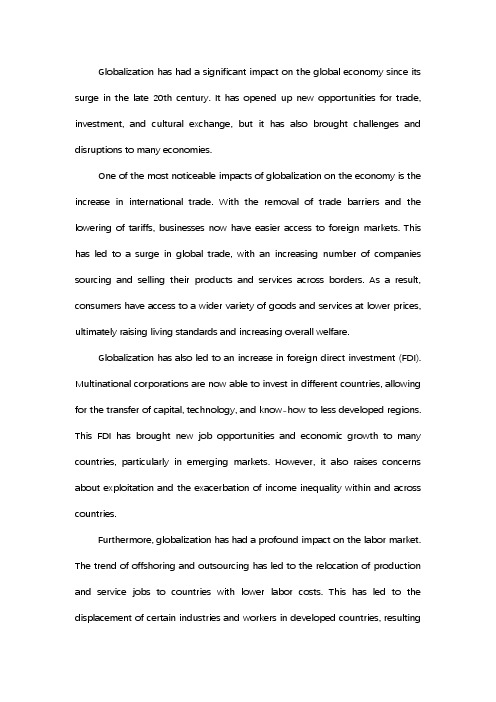
Globalization has had a significant impact on the global economy since its surge in the late 20th century. It has opened up new opportunities for trade, investment, and cultural exchange, but it has also brought challenges and disruptions to many economies.One of the most noticeable impacts of globalization on the economy is the increase in international trade. With the removal of trade barriers and the lowering of tariffs, businesses now have easier access to foreign markets. This has led to a surge in global trade, with an increasing number of companies sourcing and selling their products and services across borders. As a result, consumers have access to a wider variety of goods and services at lower prices, ultimately raising living standards and increasing overall welfare.Globalization has also led to an increase in foreign direct investment (FDI). Multinational corporations are now able to invest in different countries, allowing for the transfer of capital, technology, and know-how to less developed regions. This FDI has brought new job opportunities and economic growth to many countries, particularly in emerging markets. However, it also raises concerns about exploitation and the exacerbation of income inequality within and across countries.Furthermore, globalization has had a profound impact on the labor market. The trend of offshoring and outsourcing has led to the relocation of production and service jobs to countries with lower labor costs. This has led to the displacement of certain industries and workers in developed countries, resultingin job losses and wage stagnation. On the other hand, it has improved job opportunities and living standard for workers in developing countries.In addition, globalization has facilitated the spread of technology and innovation across countries. Companies gain access to the latest technologies from around the world and can quickly adopt and implement them in their operations. This has led to increased productivity and competitiveness in many industries, strengthening the global economy as a whole.However, the impact of globalization is not universally positive. It has also led to the increased interconnectedness of the global financial system, resulting in heightened vulnerability to financial crises. The 2008 global financial crisis, for example, spread rapidly across countries, causing severe economic downturns worldwide. In addition, the increased mobility of capital has made it easier for speculative investors to create financial instability through rapid capital flows in and out of emerging markets.Moreover, globalization has raised concerns over the environmental implications of increased production and trade. The rise in global transportation and the expansion of industrial production have contributed to higher energy consumption, greenhouse gas emissions, and environmental degradation.Finally, globalization has raised concerns about the erosion of national sovereignty. The harmonization of economic policies and regulations, as well as the rise of international trade agreements, has led to an increased transfer of authority from national governments to supranational bodies and multinationalcorporations.In conclusion, the impact of globalization on the global economy has been profound and multifaceted. While it has brought about new opportunities for growth and development, it has also created challenges and disruptions that must be carefully managed. As globalization continues to evolve, policymakers and businesses will need to address its impact on employment, inequality, the environment, and financial stability to ensure a more balanced and sustainable global economy.。
供应链管理 第三版 Unit18 习题与答案

Chapter 18E-Business and the Supply ChainTrue/False1. E-business is the execution of business transactions using Western Union.Answer: FalseDifficulty: Easy2. Supply chain transactions that involve e-business include the flow of information,product, and funds.Answer: TrueDifficulty: Moderate3. E-business enhances traditional business transactions by allowing them to takeplace over the Internet, where they can often be executed more efficiently andwith a higher level of responsiveness.Answer: TrueDifficulty: Moderate4. B2C e-business involves transactions between a company and a consumer.Answer: TrueDifficulty: Easy5. B2B e-business involves transactions between a company and the government.Answer: FalseDifficulty: Moderate6. The failure of many e-businesses was a result of the nature of e-business itself.Answer: FalseDifficulty: Easy7. An e-business allows manufacturers and other members of the supply chain thatdo not have direct contact with customers in traditional channels to enhancerevenues by bypassing intermediaries and selling directly to customers, thereby collecting the intermediary’s incremental revenue.Answer: TrueDifficulty: Moderate8. Like most retail stores, an e-business cannot attract customers who may not beable to place orders during regular business hours because an e-business hasregular business hours.Answer: FalseDifficulty: Easy9. An e-business allows a firm to increase sales by offering a very large selection ofproducts that would be unrealistic in a brick-and-mortar store.Answer: TrueDifficulty: Moderate10. The Internet offers an e-business the ability to use personal information to guideeach customer into buying items they normally would not and increase sales.Answer: FalseDifficulty: Hard11. A firm can use e-business to introduce new products much faster than a firm thatuses physical channels.Answer: TrueDifficulty: Moderate12. An e-business has to go to great effort to adjust a price in the database linked toits website.Answer: FalseDifficulty: Moderate13. E-business can greatly increase the speed with which information on customerdemand is disseminated throughout the supply chain, giving rise to moreaccurate forecasts and significantly decreasing the negative aspects of thebullwhip effect.Answer: TrueDifficulty: Moderate14. For both consumers and businesses, e-business can reduce the ease with whichone does business.Answer: FalseDifficulty: Moderate15. E-business can lower inventory levels and inventory cost by improving supplychain coordination and creating a better match between supply and demand.Answer: TrueDifficulty: Easy16. An e-business can reduce network facility costs by increasing the number offacilities used.Answer: FalseDifficulty: Easy17. With regards to ongoing operating costs, customer participation in selection andorder placement allows an e-business to lower its resource costs.Answer: TrueDifficulty: Moderate18. In situations where an e-business performs tasks currently performed by thecustomer at retail stores, all parties will experience a reduction in cost.Answer: FalseDifficulty: Moderate19. Compared to a business with many retail outlets, an e-business with aggregatedinventories will tend to have higher transportation costs (across the entire supply chain) per unit due to the increase in outbound costs.Answer: TrueDifficulty: Moderate20. The cost of software and hardware to set up an e-business is rarely significant.Answer: FalseDifficulty: Moderate21. An e-business can share demand, planning and forecast information throughoutthe supply chain to dampen the bullwhip effect and improve coordination.Answer: TrueDifficulty: Easy22. Market costs are incurred to execute a transaction and include the cost ofhandling proposals and quotations, processing orders, procurement staff, callcenters, and so forth.Answer: FalseDifficulty: Hard23. Transaction costs are reduced by automating processes, eliminating duplicationof work, reducing error rates, and decreasing cycle time during the orderplacement process.Answer: TrueDifficulty: Moderate24. Market efficiencies offer only one avenue for a firm to extract value - the pricepaid to suppliers.Answer: FalseDifficulty: Easy25. The price paid to suppliers may decrease either because of better aggregation oforders or because of increased competition between suppliers.Answer: TrueDifficulty: Easy26. Better coordination reduces utilization of available assets and matching of supplyand demand.Answer: FalseDifficulty: Moderate27. Supply chain benefits result from better coordination and collaboration acrossdifferent stages of a supply chain.Answer: TrueDifficulty: Moderate28. The coupling of e-business with the existing physical network has been referredto as bricks and mortar.Answer: FalseDifficulty: Hard29. To extract maximum benefit from e-business, firms should integrate it with theirexisting supply chain networks.Answer: TrueDifficulty: ModerateMultiple Choice1. E-business isa. shipping goods electronically.b. the execution of business transactions via the Internet.c. the use of electronic warning devices in transportation.d. the elimination of all physical assets needed for conducting business.e. none of the aboveAnswer: bDifficulty: Easy2. Which of the following transactions could not be executed with e-business?a. providing product information to participants across the supply chainb. placing orders with suppliersc. allowing customers to track ordersd. receiving payment from customerse. All of the above could be done with e-business.Answer: eDifficulty: Easy3. E-business enhances traditional business transactions by allowing them to takeplace over the Internet where they can often be executeda. less efficiently and with a lower level of responsiveness.b. less efficiently but with a higher level of responsiveness.c. more efficiently and with a higher level of responsiveness.d. more efficiently but with a lower level of responsiveness.e. none of the aboveAnswer: cDifficulty: Difficult4. E-business can be divided into two main categories:a. B2B and B2C.b. JIT and MRP.c. CRM and SRM.d. BTB and BEC.e. none of the aboveAnswer: aDifficulty: Moderate5. E-business that involves transactions between a company and a consumer isa. B2B e-business.b. B2C e-business.c. B2D e-business.d. B2S e-business.e. none of the aboveAnswer: bDifficulty: Easy6. E-business that involves transactions between two companies isa. B2B e-business.b. B2C e-business.c. B2D e-business.d. B2S e-business.e. none of the aboveAnswer: bDifficulty: Moderate7. The failure of many e-businesses has been the result ofa. the nature of e-business itself.b. designing the e-business in response to customer needs.c. how companies chose to implement e-business.d. trying to implement an e-business as part of a traditional business.e. None of the above are true.Answer: cDifficulty: Moderate8. A framework for determining the impact of e-business on a company conductingtransactions with consumers needs to considera. impact on responsibility.b. impact on responsiveness.c. impact on efficiency.d. all of the abovee. b and c onlyAnswer: aDifficulty: Moderate9. Which of the following is not an area of responsiveness that could be enhancedby e-business?a. direct sales to customersb. 24-hour access from any locationc. faster time to marketd. lower stockout levelse. reduced inventory levelsAnswer: eDifficulty: Moderate10. Which of the following is an area of responsiveness that could be enhanced by e-business?a. lower stockout levelsb. reduced inventory levelsc. fewer facilitiesd. reduced transportation coste. none of the aboveAnswer: aDifficulty: Moderate11. E-business allows manufacturers and other members of the supply chain that donot have direct contact with customers in traditional channels toa. place orders for customers.b. bypass intermediaries and sell directly to customers.c. collect the intermediary’s incremental revenue.d. all of the abovee. b and c onlyAnswer: eDifficulty: Moderate12. An e-business can attract customers who may not be able to place orders duringregular business hours becausea. an e-business is always open.b. the customer does not have to come into the store during regularbusiness hours.c. the customers can be geographically distant.d. all of the abovee. a and c onlyAnswer: dDifficulty: Easy13. An e-business allows a firm to increase sales by offering a very large selection ofproducts that would be unrealistic in a brick-and-mortar store becausea. brick-and-mortar stores are able to carry more inventory.b. an e-business must carry a large amount of inventory.c. an e-business can aggregate inventory in fewer locations.d. all of the abovee. b and c onlyAnswer: cDifficulty: Easy14. The Internet offers an e-business the ability to use personal information toa. intelligently guide each customer’s buying experience and increase sales.b. set up customer-specific sites to display information on products that thecustomer buys most frequently.c. use individual preferences and a customer’s historical purchases to r ankcurrently available choices.d. all of the abovee. a and c onlyAnswer: dDifficulty: Moderate15. A firm can use e-business to introduce new products much faster than a firm thatuses physical channels becausea. a firm selling through physical channels must produce enough units tostock the shelves at their distributors and retailers before they start to seerevenue from the new product.b. the distribution lag to fill the physical channels is profitable.c. a new product being sold through a website can be made available assoon as the first unit is ready to be produced.d. all of the abovee. a and c onlyAnswer: eDifficulty: Moderate16. Firms can change prices at an e-businessa. much less easily than most traditional channels.b. with a great deal more effort than most traditional channels.c. much more easily than most traditional channels.d. in about the same amount of time as most traditional channels..e. none of the aboveAnswer: cDifficulty: Moderate17. An e-business can price discriminate, which enables them toa. alter prices based on the characteristics of individual customers toenhance their own revenues.b. ask different customer segments to pay different prices.c. charge a single price to all customers.d. all of the abovee. a and b onlyAnswer: eDifficulty: Easy18. E-business can lower the amount of stockouts becausea. information on customer demand is disseminated throughout the supplychain much faster, giving rise to more accurate forecasts.b. the negative aspects of the bullwhip effect are significantly increased.c. there is less of a match between supply and demand.d. all of the abovee. a and c onlyAnswer: aDifficulty: Moderate19. For both consumers and businesses, e-business can increase the ease withwhich one does businessa. automating the purchasing process.b. increasing the speed of conducting business.c. decreasing the costs of placing orders.d. all of the abovee. a and b onlyAnswer: dDifficulty: Easy20. One major disadvantage of e-business relative to physical channels isa. product delivery will take longer because of the shipping time.b. immediate product delivery.c. smaller selection.d. higher product cost.e. none of the aboveAnswer: aDifficulty: Moderate21. E-business can lower inventory levels and inventory cost bya. improving supply chain coordination.b. creating a better match between supply and demand.c. aggregating inventories far from customers.d. all of the abovee. a and c onlyAnswer: eDifficulty: Moderate22. An e-business can reduce network facility costs bya. centralizing operations.b. decreasing the number of facilities required.c. increasing customer participation in selection and order placement.d. all of the abovee. a and b onlyAnswer: eDifficulty: Hard23. An e-business can reduce ongoing operating costs bya. centralizing operations.b. decreasing the number of facilities required.c. increasing customer participation in selection and order placement.d. all of the abovee. a and b onlyAnswer: cDifficulty: Hard24. In some situations, an e-business will incur greater operational costs than a retailstore becausea. customer participation in selection and order placement increased.b. an e-business has to perform tasks currently performed by the customerat retail stores.c. the number of facilities required has decreased.d. operations have been centralized.e. none of the aboveAnswer: bDifficulty: Moderate25. Compared to a business with many retail outlets, an e-business with aggregatedinventories will tend to havea. higher transportation costs (across the entire supply chain) per unit due tothe increase in inbound costs.b. higher transportation costs (across the entire supply chain) per unit due tothe increase in outbound costs.c. lower transportation costs (across the entire supply chain) per unit due tothe decrease in inbound costs.d. lower transportation costs (across the entire supply chain) per unit due tothe decrease in outbound costs.e. all of the aboveAnswer: bDifficulty: Moderate26. An e-business can improve supply chain coordination bya. sharing demand information throughout the supply chain.b. sharing planning and forecasting information within the supply chain.c. incurring additional cost for software and hardware.d. all of the abovee. a and b onlyAnswer: dDifficulty: Moderate27. The cost of software and hardware required to set up an e-businessa. is normally very reasonable.b. can often be significant.c. will only be incremental in nature.d. will greatly exceed any benefits.e. none of the aboveAnswer: bDifficulty: Hard28. E-business has allowed Dell toa. reduce inventories and dampen the bullwhip effect.b. open additional distribution and retail facilities.c. reduce the total transportation cost in the Dell supply chain.d. make significant cuts in the cost of information.e. none of the aboveAnswer: aDifficulty: Hard29. E-business has enabled toa. carry a larger inventory.b. lower facility cost.c. reduce the total transportation cost.d. reduce the cost of information.e. none of the aboveAnswer: bDifficulty: Easy30. E-business has allowed Peapod toa. lower operational facility cost.b. add additional facilities.c. reduce the total transportation cost.d. reduce the cost of information.e. none of the aboveAnswer: eDifficulty: Moderate31. Which of the following is not a source of motivation for engaging in e-business?a. reduced transaction costsb. improved supplier relationshipsc. improved market efficienciesd. supply chain benefitse. none of the aboveAnswer: bDifficulty: Hard32. These are incurred to execute a transaction and include the cost of handlingproposals and quotations, processing orders, procurement staff, call centers, and so forth.a. transaction costsb. supplier relationshipsc. market efficienciesd. supply chain benefitse. none of the aboveAnswer: aDifficulty: Easy33. These can be reduced by automating processes, eliminating duplication of work,reducing error rates, and decreasing cycle time during the order placementprocess.a. transaction costsb. supplier relationshipsc. market efficienciesd. supply chain benefitse. none of the aboveAnswer: aDifficulty: Moderate34. The price paid to suppliers is one avenue for a firm to extract value througha. reduced transaction costs.b. improved supplier relationships.c. improved market efficiencies.d. supply chain benefits.e. none of the aboveAnswer: cDifficulty: Moderate35. The ability of the firm to match surplus capacity in its supply chain with unmetdemand is an avenue for a firm to extract value througha. reduced transaction costs.b. improved supplier relationships.c. improved market efficiencies.d. supply chain benefits.e. none of the aboveAnswer: cDifficulty: Moderate36. The price paid to suppliers may decrease because ofa. better aggregation of orders.b. lack of competition between suppliers.c. increased competition between suppliers.d. all of the abovee. a and c onlyAnswer: eDifficulty: Moderate37. This results from better coordination and collaboration across different stages ofa supply chain.a. reduced transaction costsb. improved supplier relationshipsc. improved market efficienciesd. supply chain benefitse. none of the aboveAnswer: dDifficulty: Moderate38. This includes improved utilization of available assets and matching of supply anddemand.a. reduced transaction costsb. improved supplier relationshipsc. improved market efficienciesd. supply chain benefitse. none of the aboveAnswer: dDifficulty: Moderate39. Which of the following is not one of the conditions needed for e-business toreduce transaction costs by a significant amount?a. Transactions are frequent and small in size.b. Phone and fax are the current mode of transmitting orders.c. Limited buyer certification is required.d. A lot of effort is spent reconciling product and financial flows.e. none of the aboveAnswer: cDifficulty: Moderate40. Which of the following is not one of the conditions needed for B2B e-business toprovide significant value by reducing prices?a. Limited buyer/seller qualification is required.b. A fragmented market exists with many competing players either on thebuy or sell side.c. A lot of effort is spent reconciling product and financial flows.d. A large number of buyers/sellers can be attracted to the online site.e. none of the aboveAnswer: cDifficulty: Hard41. Which of the following is not a characteristic of industries where the value ofsupply chain benefits is likely to be highest?a. The bullwhip effect is relatively insignificant due to information available inthe supply chain.b. The supply chain as a whole achieves low inventory turns and poorproduct availability.c. Each stage has little visibility into either the customer or supplier stage.d. There is little collaboration in the supply chain in terms of promotions andnew product introduction.e. Product life cycles are short.Answer: aDifficulty: Hard42. To extract maximum benefit from e-business, firms shoulda. separate it from their existing supply chain networks.b. integrate it with their existing supply chain networks.c. make it more efficient than their existing supply chain networks.d. decouple it from the existing physical network.e. none of the aboveAnswer: bDifficulty: Moderate43. The e-business supply chain needs to be designed to efficiently handle returnsbecausea. customers purchasing products online are likely to have a higher rate ofreturn than customers purchasing from a physical store.b. e-businesses have no difficulty handling returns.c. the customer experience on the Internet matches that at a retail store.d. customers must return the product to the supplier that it came from.e. none of the aboveAnswer: aDifficulty: HardEssay/Problems1. How does e-business affect supply chain activities?Answer: Supply chain transactions that involve e-business include the flow ofinformation, product, and funds. For instance, the following are all transactionsthat can be executed with e-business:• Providing product information to participants across the su pply chain• Placing orders with suppliers• Allowing customers to place orders• Allowing customers to track orders• Filling and delivering orders to customers• Receiving payment from customersThese transactions are obviously not new tasks that have come into existencethrough the creation of e-business. Rather, they are traditional tasks performedby businesses for decades. E-business, however, can enhance thesetransactions by allowing them to take place over the Internet, where they canoften be executed more efficiently and with a higher level of responsiveness.Difficulty: Moderate2. How can the impact of e-business on a firm be evaluated?Answer: A framework for determining the impact of e-business on a companyconducting transactions with consumers. This e-business framework consists ofa scorecard that can be evaluated by a firm to gauge the impact of e-businessand gain insight into whether or not e-business makes sense for them. At itsmost basic level, the scorecard can be broken up into two categories:• Impact on responsiveness (which primarily affects a company’s ability togrow and protect revenue)• Impact on efficiency (which primarily affects a company’s costs) Difficulty: Moderate3. How does e-business impact the responsiveness of a firm?Answer: Improved responsiveness primarily enables a company to gain newrevenue or to protect existing revenue. An e-business allows a firm or supplychain to exploit the following responsiveness, and therefore revenue-enhancing, opportunities:• Direct sales to customers• 24-hour access from any location• Wider product portfolio and information aggregation• Personalization/customization• Faster time to market• Flexible pricing, product portfolio, and promotions• Price and service discrimination• E fficient funds transfer• Lower stockout levels• Convenience/automated processesDifficulty: Moderate4. What impact does e-business have on inventory?Answer: E-business can lower inventory levels and inventory cost by improvingsupply chain coordination and creating a better match between supply anddemand. Additionally, an e-business can aggregate inventories far fromcustomers because most customers are willing to wait for delivery of onlineorders. Due to geographical aggregation, an e-business requires less inventory.An e-business can significantly lower its inventories if it can postpone theintroduction of variety until after the customer order is received. The time lagbetween when a customer places the order and when he expects delivery offers an e-business a window of opportunity to implement postponement.5. What effect does e-business have on supply chain transportation?Answer: If a firm can put its product in a form that can be downloaded, theInternet will save on the cost and time for delivery. For nondigital products, twocomponents of transportation cost must be considered—inbound and outbound.A firm incurs inbound transportation costs to bring the replenishment order infrom the supplier. A firm incurs outbound transportation cost to take the productto the customer. Typically, replenishment orders tend to be larger than customer orders and thus the unit transportation cost is lower for inbound transportationthan for outbound transportation. Aggregating inventories increases the distancea customer order travels while decreasing the distance that a replenishmentorder travels. Compared to a business with many retail outlets, an e-businesswith aggregated inventories will tend to have higher transportation costs (across the entire supply chain) per unit due to the increase in outbound costs.Difficulty: Moderate6. Discuss the sources of motivation for a company to become involved in B2B e-business.Answer: For a business engaged in transactions with other businesses, themotivation for engaging in e-business can be broken down into value comingfrom three sources:• Reduced transaction costs• Improved market efficiencies• Supply chain benefitsTransaction costs are incurred to execute a transaction and include the cost ofhandling proposals and quotations, processing orders, procurement staff, callcenters, and so forth. Transaction costs are reduced by automating processes,eliminating duplication of work, reducing error rates, and decreasing cycle timeduring the order placement process.Market efficiencies offer two avenues for a firm to extract value—the price paid to suppliers and the ability of the firm to match surplus capacity in its supply chainwith unmet demand. The price paid may decrease either because of betteraggregation of orders or because of increased competition between suppliers.Supply chain benefits result from better coordination and collaboration acrossdifferent stages of a supply chain. Better coordination improves utilization ofavailable assets and matching of supply and demand. Improved collaborationallows different stages of a supply chain to use common information to makeproduct design and introduction, pricing, production, and distribution decisions ina manner that allows profits for each party in the supply chain to increase.Before making any investment in B2B e-business, a firm must quantify the value created under each of the three categories. The relative position of the threecategories will not be the same for all firms but will vary based on their industryand position in the supply chain. A firm must focus its e-business implementation to support categories where the value created is high relative to the cost ofimplementation. Significant value can be extracted from each of the threecategories only if the current supply chain structure has inefficiencies that can be corrected using the Internet. A firm must identify these inefficiencies to focus itse-business efforts.7. Describe how B2B e-business can provide value for a company.Answer: B2B e-business can provide significant value by reducing prices if thefollowing conditions exist:• Limited buyer/seller qualification is required.• A fragmented market exists with many competing players either on thebuy or sell side.• A large number of buyers/sellers can be attracted to the online site.B2B e-business can provide significant value by improving the matching ofsupply surplus and unmet demand in industries where capacity is expensive and mismatches of surplus supply and unmet demand are common. If significantbuyer/seller qualification is required, the ability of the Internet channel to provide market efficiencies by decreasing prices is diminished. Market efficiencies aremuch more likely to decrease prices if buyer/seller qualification is not importantand the market is highly fragmented. In such a situation, a truly lower costsupplier is likely to be identified, providing real supply chain value. Marketefficiencies are also likely to decrease prices when many small buyers use theInternet as an infrastructure for aggregating orders. In most supply chains, themajor value from market efficiencies will derive from matching surplus supplywith unmet demand.Difficulty: Moderate8. Explain how firms can gain the supply chain benefits of e-business.Answer: The value of supply chain benefits is likely to be highest in industrieswith the following characteristics:• The bull whip effect is quite significant due to information distortion in thesupply chain.• The s upply chain as a whole achieves low inventory turns and poorproduct availability.• Each stage has little visibility into either the customer or supplier stage.• There is little collaboration in the supp ly chain in terms of promotionsand new product introduction.• Product life cycles are short.At the most basic level, the Internet allows increased visibility across a supplychain. This visibility offers value if all stages can plan to anticipate consumerdemand. The value of visibility increases with the number of stages in the supply chain. The full value of visibility, however, is only achieved when different stages of the supply chain plan their activities collaboratively based on a commonforecast of customer demand. Achieving visibility is often difficult, butcollaboration in planning and new product introduction is even harder because it requires significant changes in organizational structure along with theimplementation of technology. In fact, a case can be made that the organizational changes play a more important role than technology when implementingcollaboration. Potential benefits from collaboration, however, will far exceed thebenefits obtained from simple visibility.Difficulty: Moderate。
跨境电商英语试题及答案

跨境电商英语试题及答案一、选择题(每题2分,共20分)1. What does "B2B" stand for in e-commerce?A. Business to BusinessB. Business to ConsumerC. Consumer to ConsumerD. Business to Government2. Which of the following is not a common payment method in cross-border e-commerce?A. Credit cardB. PayPalC. Bank transferD. Cash on delivery3. What is the abbreviation for "Free On Board"?A. FOBB. MOQC. ROID. SKU4. In cross-border e-commerce, what does "DHL" refer to?A. Digital Home LivingB. Direct Home LogisticsC. Door to Home LogisticsD. None of the above5. Which of the following is a key factor for success incross-border e-commerce?A. Product qualityB. Customer serviceC. Competitive pricingD. All of the above6. What is the role of a "dropshipper" in e-commerce?A. A manufacturer of productsB. A retailer that stocks productsC. A retailer that doesn't stock products but fulfills orders directly from the manufacturerD. A distributor of products7. What does "SEO" stand for in digital marketing?A. Search Engine OptimizationB. Social Engine OptimizationC. Systemic Electronic OrderingD. Secure Electronic Ordering8. Which of the following is not a social media platform?A. FacebookB. TwitterC. WeChatD. Yahoo9. What is the purpose of using "A/B testing" in e-commerce?A. To test different product designsB. To compare two versions of a webpage to see which performs betterC. To test the efficiency of different payment methodsD. To compare different customer service strategies10. What is the meaning of "CTR" in online advertising?A. Click-Through RateB. Cost To ReachC. Conversion Through RateD. Customer Transaction Ratio二、填空题(每空2分,共20分)11. The term "e-commerce" refers to buying and selling goods or services over the _______.12. In cross-border e-commerce, the process of returning goods is known as _______.13. The term "EDI" stands for _______ Data Interchange.14. A(n) _______ is a person who purchases goods or services from a seller.15. The acronym "API" refers to Application Programming_______.16. When a product is shipped internationally, it is subject to _______ duties and taxes.17. The _______ is a document that accompanies a shipment and lists the contents and their value.18. A(n) _______ is a method of payment where the buyer's bank guarantees payment to the seller.19. "EAN" stands for European _______ Number.20. The process of adapting a product or service to aspecific market is known as _______.三、简答题(每题10分,共20分)21. What are the main challenges faced by businesses incross-border e-commerce?22. Explain the importance of cultural adaptation in cross-border e-commerce marketing strategies.四、论述题(每题15分,共30分)23. Discuss the role of logistics in the success of cross-border e-commerce.24. Analyze the impact of technological advancements on the cross-border e-commerce industry.五、案例分析题(10分)25. A small business owner is considering expanding into cross-border e-commerce. What advice would you give them regarding market research, legal compliance, and supply chain management?答案:一、选择题1. A2. D3. A4. D5. D6. C7. A8. D9. B 10. A二、填空题11. internet 12. reverse logistics 13. Electronic 14. consumer 15. Interface 16. customs 17. invoice 18. letter of credit 19. Article 20. localization三、简答题21. 主要挑战包括语言和文化差异、复杂的法律法规、支付和物流问题、货币汇率波动以及知识产权保护等。
The impact of market competition and budgetary participation on performance and job satisfaction
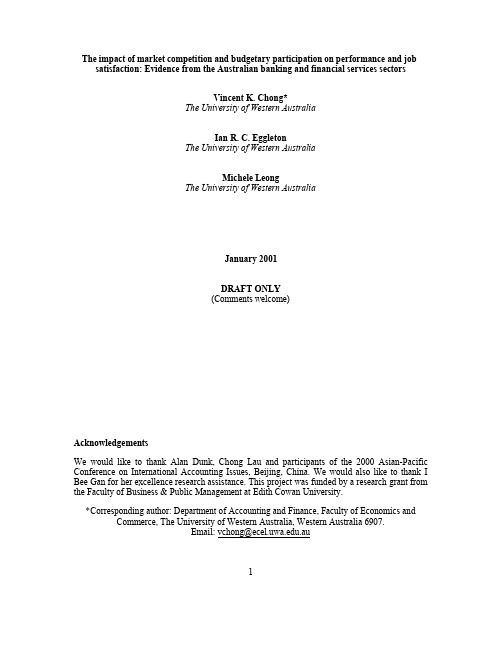
The impact of market competition and budgetary participation on performance and job satisfaction: Evidence from the Australian banking and financial services sectorsVincent K. Chong*The University of Western AustraliaIan R. C. EggletonThe University of Western AustraliaMichele LeongThe University of Western AustraliaJanuary 2001DRAFT ONLY(Comments welcome)AcknowledgementsWe would like to thank Alan Dunk, Chong Lau and participants of the 2000 Asian-Pacific Conference on International Accounting Issues, Beijing, China. We would also like to thank I Bee Gan for her excellence research assistance. This project was funded by a research grant from the Faculty of Business & Public Management at Edith Cowan University.*Corresponding author: Department of Accounting and Finance, Faculty of Economics and Commerce, The University of Western Australia, Western Australia 6907.Email: vchong@.au1The impact of market competition and budgetary participation on performance and job satisfaction: Evidence from the Australian banking and financial services sectorsAbstractThis paper examines the impact of the intensity of market competition and budgetaryparticipation on performance and job satisfaction. The responses of 77 seniormanagers, drawn from a cross-section of Australian banking and financial servicessectors, to a questionnaire survey were analyzed by using a multiple regressiontechnique. The results showed that the higher the intensity of market competition,the more positive is the relationship between budgetary participation andperformance and job satisfaction.Key words: Budgetary participation, Intensity of market competition, banking and financial services sectors, performance and job satisfaction2ReferencesAbernethy, M. A. and Stoelwinder, J. U. (1995). ‘The role of professional control in the management of complex organizations’. Accounting, Organizations and Society: 1-17. Allison, P. D. (1977). ‘Testing for interaction in multiple regression’. American Journal of Sociology: 144-153. Argyris, C. (1952). The Impact of People on Budgets. New York: Controllership Foundation. Bass, B. M. and Leavitt, H. J. (1963). ‘Some experiments in planning and operating’.Management Science: 574-585. Becker, S. and Green, D. (1962). Budgeting and employee behavior. Journal of Business: 392-402. Brownell, P. (1981). ‘Participation in budgeting, locus of control and organizationaleffectiveness’. The Accounting Review: 844-860. Brownell, P. (1982a). ‘A field study examination of budgetary participation and locus of control’.The Accounting Review: 766-777. Brownell, P. (1982b). ‘Participation in the budgeting process: When it works and when itdoesn’t’. Journal of Accounting Literature: 124-153. Brownell, P. (1982c). ‘The role of accounting data in performance evaluation, budgetaryparticipation and organizational effectiveness’. Journal of Accounting Research: 12-27. Brownell, P. (1983). ‘Leadership style, budgetary participation and managerial behavior’.Accounting, Organizations and Society: 307-321. Brownell, P. (1985). ‘Budgetary systems and the control of functionally differentiatedorganisational activities’. Journal of Accounting Research: 502-512. Brownell, P., and McInnes, M. (1986). Budgetary participation, motivation, and managerialperformance. The Accounting Review: 587-600 Brownell, P. and Dunk, A. S. (1991).‘Task uncertainty and its interaction with budgetaryparticipation and budget emphasis: Some methodological issues and empirical investigation’.Accounting, Organizations and Society, 16 (8): 693-703. Bryan, J. F. and Locke, E. A. (1967). ‘Goal setting as a means of increasing motivation’. Journalof Applied Psychology: 274-277. Champoux, J. E. and Peters, W. S. (1987). Form, Effect Size and Power in Moderated RegressionAnalysis, Journal of Occupational Psychology: 243-255. Chenhall, R. H. (1986).‘Authoritarianism and participative budgeting: A dyadic analysis’. TheAccounting Review: 263-272. Chenhall, R. H. and Morris, D. (1986). ‘The impact of structure, environment, andinterdependence on the perceived usefulness of management accounting systems’. TheAccounting Review: 16-35. Chenhall, R. H. and Brownell, P. (1988). ‘The effect of participative budgeting on job satisfactionand performance: role ambiguity as an intervening variable’. Accounting, Organizations and Society, 13 (3): 225-233. Cherrington, D. J. and Cherrington, J. O. (1973). ‘Appropriate reinforcement contingencies in the budgeting process’. Empirical Research in Accounting: Selected Studies, Supplement to Journal of Accounting Research: 225-253. Chong, V. K. (1996). ‘Management accounting systems, task uncertainty and managerialperformance: A research note’. Accounting, Organizations and Society: 415-421. Chong, V. K. and Bateman, D. (2000). ‘The effect of role stress on budgetary participation and job satisfaction-performance linkages: A test of two different models’. Advances inAccounting Behavioral Research, 3:91-118.37Chong, V. K. and Chong, K. M. (1997). ‘Strategic choices, environmental uncertainty and SBU performance: A note on the intervening role of management accounting systems’. Accounting and Business Research, 27: 268-276.Chong, V. K. and Chong, K. M. (2000). ‘A test of the effects of motivational and informational roles of budget participation on performance: A structural equation modeling approach’. A paper presented at the 2000 Management Accounting Research Conference and Case Symposium, Mesa, Arizona, USA.Chow, C., Cooper, J. and Waller, W. (1988). ‘Participative Budgeting: Effects of a Truth-Inducing Pay Scheme and Information Asymmetry on Slack and Performance’. The Accounting Review: 111-121Cronbach, L. J. (1951). ‘Coefficient alpha and the internal structure of tests’. Psychometrika: 297-334.Dewar, R. and Werbel, J. (1979). ‘Universalistic and contingency predictions of employee satisfaction and conflict’. Administrative Science Quarterly: 313-327.Dunk, A. S. (1990). ‘Budgetary Participation, Agreement on Evaluation Criteria and Managerial Performance: A Research Note’. Accounting, Organizations and Society: 171-178. French, J. R. P. Jr., Israel, J. and As, D. (1960). ‘An experiment on participation in Norwegian factory: Interpersonal dimensions of decision-making’. Human Relations: 3-19. Galbraith, J. R. (1973). Designing Complex Organizations, Readings, MA: Addison-Wesley. Galbraith, J. R. (1977). Organization Design, Readings, MA: Addison-Wesley.Greenberg, P. S., Greenberg, R. H. and Nouri, H. (1994). ‘Participative budgeting: A Meta-analytic examination of methodological moderators’. Journal of Accounting Literature, 13: 117-141.Gordon, L. A. and Narayanan, V. K. (1984). Management accounting systems, perceived environmental uncertainty and organizational structure: An empirical investigation, Accounting, Organizations and Society, 9: 33-47.Govindarajan, V. (1986). ‘Impact of participation in the budgetary process on managerial attitudes and performance: universalistic and contingency perspectives’. Decision Sciences: 496-516.Govindarajan, V. and Fisher, J. (1990). ‘Strategy, control systems and resource sharing: Effects on business-unit performance’. Academy of Management Journal, 33 (2): 259-285.Gul, F. A. (1991). ‘The effects of management accounting systems and environmental uncertainty on small business managers' performance’. Accounting and Business Research: 57-61.Gul, F. A. and Chia, Y. M. (1994). ‘The effects of management accounting systems, perceived environmental uncertainty and decentralization on managerial performance: A test of three-way interaction’. Accounting, Organizations and Society: 413-426.Gul, F. A., Tsui, J. S. L., Fong, S. C. C. and Kwok, H. Y. L. (1995). ‘Decentralization as a moderating factor in the budgetary participation-performance Relationship: Some Hong Kong evidence’. Accounting and Business Research, 98: 107-113.Hartmann, F. G. H. and Moers, F., (1999). ‘Testing contingency hypotheses in budgetary research: An evaluation of the use of moderated regression analysis, Accounting, Organizations and Society: 291-315.Hassel, L. G. and Cunningham, G. M. (1996). ‘Budget effectiveness in multinational corporations: an empirical test of the use of budget controls moderated by two dimensions of budgetary participation under high and low environmental dynamism’. Management International Review: 245-266.Hofstedt (1968). The Game of Budget Control. London: Tavistock.Hopwood, A. G. (1974). Accounting and Human Behavior. Haymarket Publishing Ltd. Hopwood, A. G. (1976). Accounting and Human Behavior. Englewood Cliffs: N. J.: Prentice-Hall.38Jaccard, J., Turrisi, R. and Wan, C. K. (1990). Interaction Effects in Multiple Regression, Newbury Park: Sage. Kaiser, H. F. (1974). ‘An index of factorial simplicity’. Psychometrika, 39: 31-36. Kenis, I. (1979). ‘Effects of budgetary goal characteristics on managerial attitudes and performance’. The Accounting Review: 707-721. Kerlinger, F. N. (1964). Foundations of Behavioral Research. New York: Holt, Rinehart andWinston. Kessler, L. and Ashton, R. H. (1981). ‘Feedback and prediction achievement in financialanalysis’. Journal of Accounting Research: 146-162. Kompass Australia. (1999). Prahran: Peter Isaacson. Kren, L. (1992). ‘Budgetary participation and managerial performance: The impact ofinformation and environmental volatility’. The Accounting Review, 67: 511-526. Kren, L. and W. M. Liao. 1988. ‘The role of accounting information in the control oforganizations: A review of the evidence’. Journal of Accounting Literature: 280-309. Lau, C. M., Low, L. C. and Eggleton, I. R. C. (1995). ‘The impact of reliance on accountingperformance measures on job-related tension and managerial performance: additionalevidence’. Accounting, Organizations and Society, 20 (5): 359-381. Lau, C. M., Low, L. C. and Eggleton, I. R. C. (1997). ‘The interactive effect of budget emphasis,participation and task difficulty on managerial performance: A cross-cultural study’. Accounting, Auditing and Accountability Journal, 10 (2): 175-197. Lau, C. M. and Tan, J. J. (1998). ‘The impact of budget emphasis, participation and task difficulty on managerial performance: A cross-cultural study of the financial services sector’. Management Accounting Research, 9: 163-183. Leblebici, H. and Salancik, G. R. (1981). ‘Effects of environmental uncertainty on informationand decision processes in banks’. Administrative Sciences Quarterly, 26: 578-596. Lindquist, T. (1995). ‘Fairness as an antecedent to participative budgeting: Examining the effects of distributive justice, procedural justice and referent cognitions on satisfaction and performance’. Journal of Management Accounting Research, 7: 122-147. Lindsay, R. M. and Ehrenberg, A. S.C. (1993). The design of replicated studies. The AmericanStatistician, 47: 217-228. Lorsch, J. W. and Morse, J. J. (1974). Organizations and Environment, Homewood, IL.: Irwin. Magner, N., Welker, R. B. and Campbell, T. L. (1996). Testing a model of cognitive budgetaryparticipation processes in a latent variable structural equations framework. Accounting and Business Research, 27 (1): 41-50. Mensah, K. E. (1981). ‘The external organizational environment and its impact on managementinformation systems’. Accounting, organizations and society, 6: 301-316. Merchant, K. A. (1981). ‘The design of the corporate budgeting system: Influence on managerial behavior and performance’. The Accounting Review, 56: 813-829. Mia, L. (1988).‘Managerial attitude, motivation, and the effectiveness of budget participation’.Accounting, Organizations and Society 13 (5): 465-475. Mia, L. (1989). ‘The impact of participation in budgeting and job satisfaction on managerialperformance and work motivation: A research note’. Accounting, Organizations and Society,14 (4): 347-357. Mia, L. (1993). ‘The role of MAS information in organizations: An empirical study’. BritishAccounting Review: 269-285. Mia, L. and Chenhall, R. H. (1994). ‘The usefulness of management accounting systems,functional differentiation and managerial effectiveness’. Accounting, Organizations andSociety: 1-13. Mia, L. and Clarke, B. (1999). ‘Market competition, management accounting systems andbusiness unit performance’. Management Accounting Research, 10: 137-158.39Milani, K. (1975). ‘The relationship of participation in budget setting to industrial supervisor performance and attitudes: A field study’. The Accounting Review: 274-284. Murray, D. (1990). ‘The performance effect of participative budgeting: An integration ofintervening and moderating variables’. Behavioral Research in Accounting, 2: 104-123. Myer, R. (1990). Classical and Modern Regression with Application. New York: McGraw-Hill. Neter, J., Wasserman, W. and Kutner, M. (1985). Applied Linear Regression Models.Homewood, Ill.: Irwin. Nouri, H. and Parker, R. J. (1996). The effect of organizational commitment on the relationbetween budgetary participation and budgetary slack. Behavioral Research in Accounting 8:74-90. Nouri, H. and Parker, R. J. (1998). The relationship between budget participation and job performance: The role of budget adequacy and organizational commitment. Accounting,Organizations and Society, 23: 467-483. Nunnally, J. C. (1967). Psychometric Theory. New York: McGraw-Hill. Prien, E. P. and Liske, R. E. (1962). Assessment of higher-level personnel: III. rating criteria: Acomparative analysis of supervision ratings and incumbent self-rating of job performance.Personnel Psychology 32(3): 187-194. O’Connell, J. M., Cumming, L. L. and Huber, G. P. (1976). The effects of environmentalinformation and decision unit structure on felt tension, Journal of Applied Psychology: 493-500. Pedhazur, E. J. (1982). Multiple Regression in Behavioural Research, Explanation and Prediction. Holt, Rinehart Winston. Ronen, J. and Livingstone, J. L. (1975). ‘An expectancy theory approach to the motivationalimpact of budgets’. The Accounting Review: 671-685. Schoonhoven, C. B. (1981). Problems with contingency theory: Testing assumptions hiddenwithin the language of contingency theory, Administrative Science Quarterly: 349-377. Shields, J.F. and Shields, M. D. (1998). Antecedents of participative budgeting. Accounting,Organizations and Society: 49-76. Southwood, K. E. (1978). Substantive theory and statistical interactions: Five models. AmericanJournal of Sociology: 1154-1203. Stedry, A. C. (1960). Budget Control and Cost Behaviour. Englewood, Cliffs, N. J.: Prentice-Hall. The Australian. (1999). Brave new banking’s losers (3 November). The West Australian (2000). Westpac fuels net war with $15 trade. (1 April). Thompson, J. D. (1967). Organization in action. McGraw-Hill. Thornton, G. C. (1968). The relationship between supervisory and self-appraisals of executiveperformance. Personnel Psychology 21(21): 441-456. Tushman, M. L. and Nadler, D. A. (1978). Information processing as an integrating concept inorganizational design, Academy of Management Review: 613-624.Vroom, V. H. (1964). Work and Motivation, New York: Wiley.。
The impact of globalization on the economy
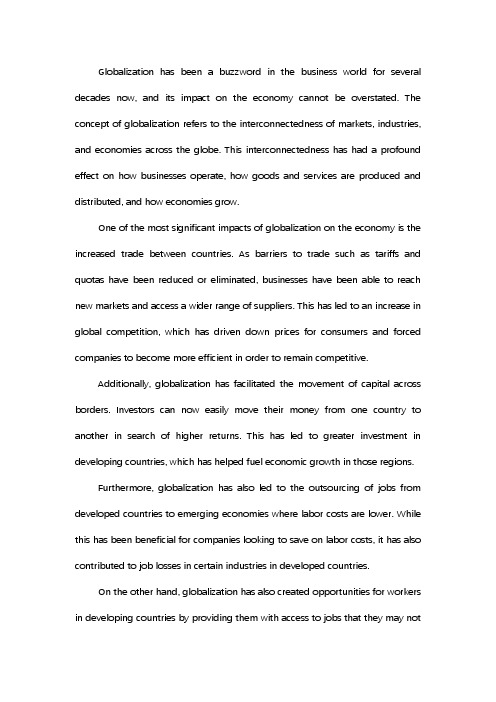
Globalization has been a buzzword in the business world for several decades now, and its impact on the economy cannot be overstated. The concept of globalization refers to the interconnectedness of markets, industries, and economies across the globe. This interconnectedness has had a profound effect on how businesses operate, how goods and services are produced and distributed, and how economies grow.One of the most significant impacts of globalization on the economy is the increased trade between countries. As barriers to trade such as tariffs and quotas have been reduced or eliminated, businesses have been able to reach new markets and access a wider range of suppliers. This has led to an increase in global competition, which has driven down prices for consumers and forced companies to become more efficient in order to remain competitive.Additionally, globalization has facilitated the movement of capital across borders. Investors can now easily move their money from one country to another in search of higher returns. This has led to greater investment in developing countries, which has helped fuel economic growth in those regions.Furthermore, globalization has also led to the outsourcing of jobs from developed countries to emerging economies where labor costs are lower. While this has been beneficial for companies looking to save on labor costs, it has also contributed to job losses in certain industries in developed countries.On the other hand, globalization has also created opportunities for workers in developing countries by providing them with access to jobs that they may nothave otherwise had. This influx of jobs has lifted millions of people out of poverty and fueled economic development in many parts of the world.In addition to these direct impacts on trade and labor markets, globalization has also had indirect effects on economic policy and regulation. As countries become more integrated into the global economy, they often find themselves having to align their policies with international standards in order to remain competitive. This can lead to changes in areas such as taxation, environmental regulation, and intellectual property rights.While there are certainly many benefits associated with globalization, there are also some drawbacks that need to be considered. For example, some critics argue that globalization can lead to an erosion of local cultures as Western values and products become dominant around the world. Additionally, there is concern that globalization can exacerbate income inequality both within and between countries.Overall, it is clear that globalization has had a profound impact on the global economy over the past few decades. It has led to increased trade flows, greater capital mobility, and changes in economic policy around the world. While there are certainly challenges associated with this process, there is also evidence that it has contributed significantly to global economic growth and development.As we look ahead into an increasingly interconnected world economy,it will be essential for policymakers,businesses,and individuals alike,to carefullyconsider both its benefits,and its potential downsides,in order ti shape a future where all people can benefit from this powerful force called Globalization.。
ACCA牛津布鲁克斯学位论文选题参考
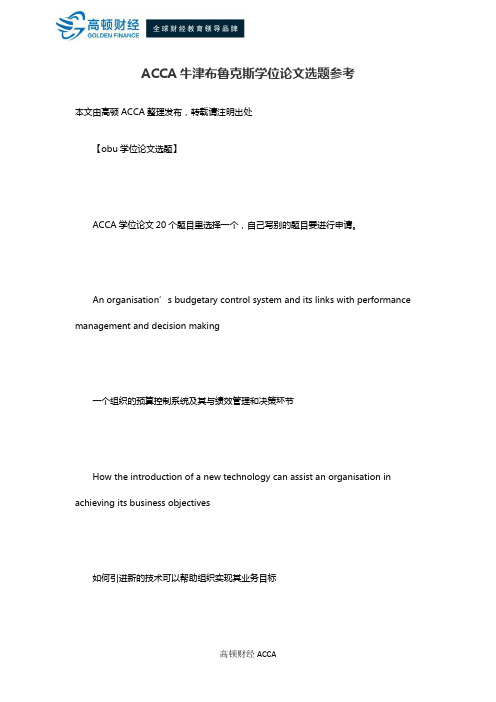
ACCA牛津布鲁克斯学位论文选题参考本文由高顿ACCA整理发布,转载请注明出处【obu学位论文选题】ACCA学位论文20个题目里选择一个,自己写别的题目要进行申请。
An organisation’s budgetary control system and its links with performance management and decision making一个组织的预算控制系统及其与绩效管理和决策环节How the introduction of a new technology can assist an organisation in achieving its business objectives如何引进新的技术可以帮助组织实现其业务目标The impact of an aspect of impending legislation on the operations and financial position of an organisation即将发生的立法的一个方面对运营组织的影响和财务状况The impact of e-business on an organisation电子商务对组织的影响The effects of globalisation on an organisation全球化对组织的影响The key factors or indicators in the motivation of employees in an organisation在员工中的动机的关键因素或指标组织The restructuring of an organisation’s operational activities and the effect on the organisation’s financial performance一个组织的业务活动的调整和对组织的财务绩效的影响The business and financial performance of an organisation over a three year period一个组织的业务及财务表现在三年期The planning and implementation of an information system in an organisation规划和实施的信息系统在组织The effectiveness of the use of costing techniques within an organisation利用成本的技术在组织内的效果The financial and operational costs and benefits of the internal audit / internal review activities within an organisation组织内的财务和运营成本,内部审计/内部审查活动的好处The possible effects of a proposed accounting standard on the financial statements and business activities of an organisation一事一议的会计准则对组织的财务报表和经营活动可能产生的影响The relationship between an organisation’s human resources activities and its business objectives一个组织的人力资源活动与业务目标之间的关系The business and financial objectives of a strategic investment decision made by an organisation and its impact on key stakeholders战略投资决策的一个组织及其对主要利益相关方的影响所做的业务和财务目标The management of an organisation’s working capital over a three year period and its impact on the organisation’s funding strategies一个组织的营运资金在三年期内的管理及其对企业的融资战略的影响The financial and operational risk management within an organisation组织内的财务和运营风险管理The quality of the corporate governance within an organisation and公司治理的组织内部的质量和the impact on an organisation’s key stakeholders对一个组织的关键利益相关者的影响The marketing strategy of an organisation and its effectiveness组织及其成效的营销策略The financial and operational consequences of a merger between two organisations or of the acquisition of one organisation by another合并的两个组织之间的收购一个组织由另一个或财务及营运影响更多ACCA资讯请关注高顿ACCA官网:。
自考英语二作文题目
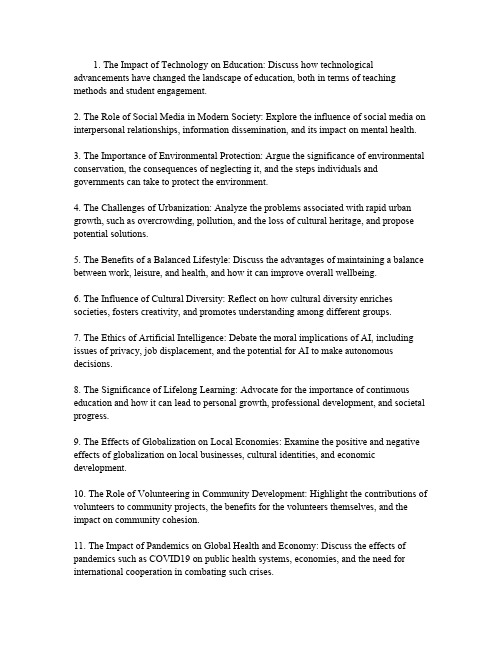
1.The Impact of Technology on Education:Discuss how technological advancements have changed the landscape of education,both in terms of teaching methods and student engagement.2.The Role of Social Media in Modern Society:Explore the influence of social media on interpersonal relationships,information dissemination,and its impact on mental health.3.The Importance of Environmental Protection:Argue the significance of environmental conservation,the consequences of neglecting it,and the steps individuals and governments can take to protect the environment.4.The Challenges of Urbanization:Analyze the problems associated with rapid urban growth,such as overcrowding,pollution,and the loss of cultural heritage,and propose potential solutions.5.The Benefits of a Balanced Lifestyle:Discuss the advantages of maintaining a balance between work,leisure,and health,and how it can improve overall wellbeing.6.The Influence of Cultural Diversity:Reflect on how cultural diversity enriches societies,fosters creativity,and promotes understanding among different groups.7.The Ethics of Artificial Intelligence:Debate the moral implications of AI,including issues of privacy,job displacement,and the potential for AI to make autonomous decisions.8.The Significance of Lifelong Learning:Advocate for the importance of continuous education and how it can lead to personal growth,professional development,and societal progress.9.The Effects of Globalization on Local Economies:Examine the positive and negative effects of globalization on local businesses,cultural identities,and economic development.10.The Role of Volunteering in Community Development:Highlight the contributions of volunteers to community projects,the benefits for the volunteers themselves,and the impact on community cohesion.11.The Impact of Pandemics on Global Health and Economy:Discuss the effects of pandemics such as COVID19on public health systems,economies,and the need for international cooperation in combating such crises.12.The Importance of Mental Health Awareness:Address the prevalence of mental health issues,the stigma associated with them,and the importance of raising awareness and providing support.13.The Challenges and Opportunities of Remote Work:Evaluate the benefits and drawbacks of working from home,including increased flexibility,potential isolation,and the need for effective communication.14.The Role of Education in Promoting Equality:Discuss how education can serve as a tool for social mobility,reducing inequalities,and fostering a more inclusive society.15.The Ethics of Genetic Engineering:Delve into the ethical considerations surrounding genetic modification,including potential benefits and risks,and the implications for future generations.。
大学优质英语作文十四篇
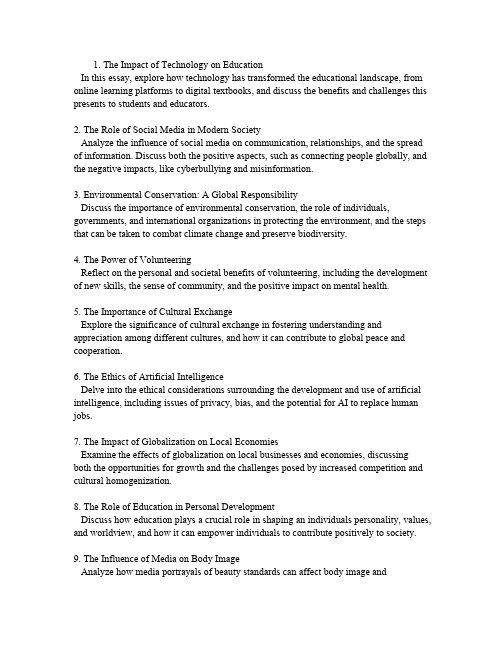
1.The Impact of Technology on EducationIn this essay,explore how technology has transformed the educational landscape,from online learning platforms to digital textbooks,and discuss the benefits and challenges this presents to students and educators.2.The Role of Social Media in Modern SocietyAnalyze the influence of social media on communication,relationships,and the spread of information.Discuss both the positive aspects,such as connecting people globally,and the negative impacts,like cyberbullying and misinformation.3.Environmental Conservation:A Global ResponsibilityDiscuss the importance of environmental conservation,the role of individuals, governments,and international organizations in protecting the environment,and the steps that can be taken to combat climate change and preserve biodiversity.4.The Power of VolunteeringReflect on the personal and societal benefits of volunteering,including the development of new skills,the sense of community,and the positive impact on mental health.5.The Importance of Cultural ExchangeExplore the significance of cultural exchange in fostering understanding and appreciation among different cultures,and how it can contribute to global peace and cooperation.6.The Ethics of Artificial IntelligenceDelve into the ethical considerations surrounding the development and use of artificial intelligence,including issues of privacy,bias,and the potential for AI to replace human jobs.7.The Impact of Globalization on Local EconomiesExamine the effects of globalization on local businesses and economies,discussing both the opportunities for growth and the challenges posed by increased competition and cultural homogenization.8.The Role of Education in Personal DevelopmentDiscuss how education plays a crucial role in shaping an individuals personality,values, and worldview,and how it can empower individuals to contribute positively to society.9.The Influence of Media on Body ImageAnalyze how media portrayals of beauty standards can affect body image andselfesteem,and discuss the importance of promoting a diverse range of body types and promoting selfacceptance.10.The Benefits of a Balanced LifestyleExplore the advantages of maintaining a balanced lifestyle,including physical health, mental wellbeing,and social connections,and provide tips on achieving this balance. 11.The Challenges of UrbanizationDiscuss the challenges that come with rapid urbanization,such as overcrowding, pollution,and the strain on resources,and propose potential solutions to these issues. 12.The Significance of Mental Health AwarenessAdvocate for the importance of mental health awareness and the need to destigmatize mental health issues,emphasizing the role of education,support systems,and professional help.13.The Evolution of CommunicationReflect on how communication has evolved over time,from traditional letters to modern digital communication,and the impact this has had on our relationships and the way we share information.14.The Importance of Lifelong LearningEmphasize the value of lifelong learning for personal growth,career development,and staying relevant in a rapidly changing world,and discuss the various ways individuals can continue to learn and grow throughout their lives.。
如何影响商业观念英语作文
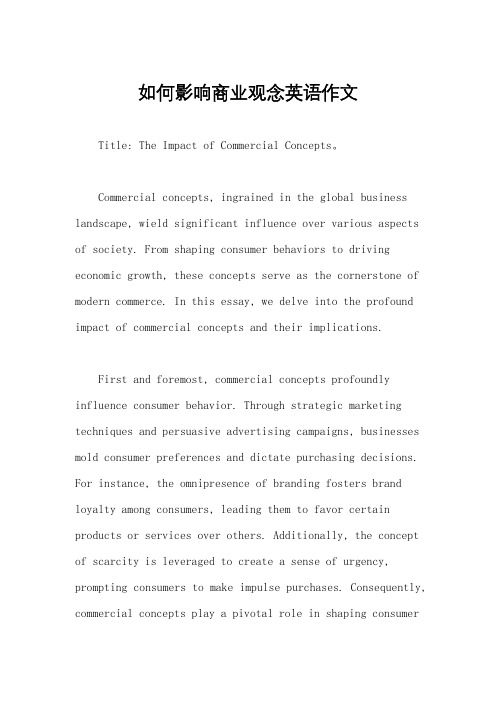
如何影响商业观念英语作文Title: The Impact of Commercial Concepts。
Commercial concepts, ingrained in the global business landscape, wield significant influence over various aspects of society. From shaping consumer behaviors to driving economic growth, these concepts serve as the cornerstone of modern commerce. In this essay, we delve into the profound impact of commercial concepts and their implications.First and foremost, commercial concepts profoundly influence consumer behavior. Through strategic marketing techniques and persuasive advertising campaigns, businesses mold consumer preferences and dictate purchasing decisions. For instance, the omnipresence of branding fosters brand loyalty among consumers, leading them to favor certain products or services over others. Additionally, the concept of scarcity is leveraged to create a sense of urgency, prompting consumers to make impulse purchases. Consequently, commercial concepts play a pivotal role in shaping consumerpsychology and driving market demand.Furthermore, commercial concepts exert a significant influence on economic dynamics. The principles of supply and demand, fundamental to commercial theory, govern market equilibrium and pricing mechanisms. By understanding these concepts, businesses can optimize production levels and allocate resources efficiently to meet consumer needs. Moreover, concepts such as economies of scale enable businesses to achieve cost efficiencies through mass production, thereby enhancing profitability. Consequently, a deep understanding of commercial concepts is essentialfor businesses to navigate the intricacies of the market and achieve sustainable growth.Moreover, commercial concepts have far-reaching implications for societal values and norms. The commodification of goods and services has led to the monetization of various aspects of life, blurring the lines between personal and commercial domains. This phenomenon is particularly evident in the rise of influencer marketing, where individuals monetize their personal brand andlifestyle for commercial gain. Consequently, commercial concepts not only shape consumer behavior but also influence societal perceptions of success and status.Additionally, commercial concepts play a pivotal role in driving innovation and technological advancement. The pursuit of profit incentivizes businesses to invest in research and development, leading to the creation of groundbreaking products and services. Concepts such as disruptive innovation and creative destruction redefine industry landscapes, ushering in new opportunities for growth and development. Moreover, the concept of intellectual property rights fosters innovation by protecting the fruits of creative labor, thereby encouraging investment in innovation-intensive industries.Furthermore, commercial concepts intersect with cultural dynamics, giving rise to hybrid forms of commerce that cater to diverse consumer preferences. The globalization of commerce has facilitated the exchange of ideas and cultural practices, leading to the emergence of cross-cultural marketing strategies. Businesses must adapttheir commercial concepts to resonate with culturally diverse audiences, thereby fostering inclusivity and promoting cultural exchange. Consequently, commercial concepts serve as a bridge between different cultures, facilitating global interconnectedness and understanding.In conclusion, commercial concepts wield profound influence over various aspects of society, ranging from consumer behavior to economic dynamics and cultural values. By understanding and harnessing these concepts, businesses can navigate the complexities of the market and drive innovation and growth. However, it is imperative to recognize the ethical implications of commercial practices and strive for a balance between profit maximization and social responsibility. Only then can we harness the transformative power of commercial concepts for the betterment of society.。
2024管理类联考考研英语二词汇-词源144、coalition
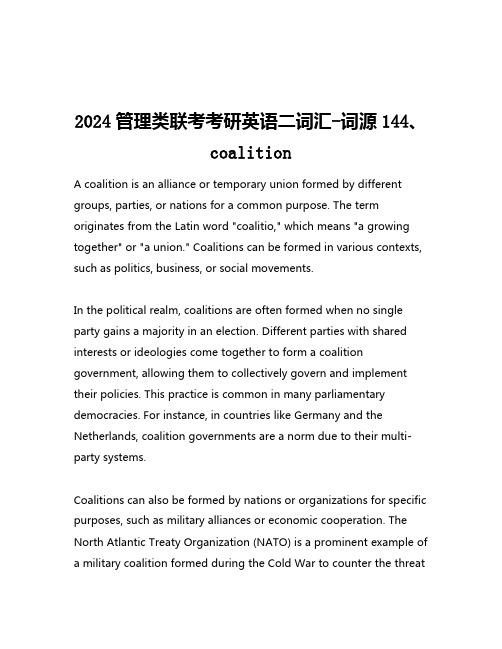
2024管理类联考考研英语二词汇-词源144、coalitionA coalition is an alliance or temporary union formed by different groups, parties, or nations for a common purpose. The term originates from the Latin word "coalitio," which means "a growing together" or "a union." Coalitions can be formed in various contexts, such as politics, business, or social movements.In the political realm, coalitions are often formed when no single party gains a majority in an election. Different parties with shared interests or ideologies come together to form a coalition government, allowing them to collectively govern and implement their policies. This practice is common in many parliamentary democracies. For instance, in countries like Germany and the Netherlands, coalition governments are a norm due to their multi-party systems.Coalitions can also be formed by nations or organizations for specific purposes, such as military alliances or economic cooperation. The North Atlantic Treaty Organization (NATO) is a prominent example of a military coalition formed during the Cold War to counter the threatposed by the Soviet Union. Similarly, the European Union (EU) is an economic and political coalition of European countries, promoting integration and cooperation among its member states.In the business world, companies sometimes form coalitions or strategic alliances to combine their resources, expertise, and market reach. These coalitions can help them compete more effectively, enter new markets, or jointly develop new products or services. Examples of business coalitions include airline alliances, such as Star Alliance and Oneworld, where multiple airlines collaborate to offer seamless travel experiences to their customers.Coalitions can also emerge in social movements or advocacy groups, where different organizations or individuals unite to amplify their voices and achieve a common goal. Environmental coalitions, human rights coalitions, and coalitions for social justice are examples of such coalitions that leverage collective power to effect change.While coalitions can be powerful and effective, they often face challenges in maintaining unity and resolving internal conflicts. Divergent interests, power struggles, and differing priorities among coalition members can strain the alliance and hinder progress towards shared objectives. Effective communication, compromise, and a strong commitment to the common cause are essential for ensuring the longevity and success of coalitions.In summary, coalitions are formed when diverse groups or entities come together to leverage their collective strength and resources for a common purpose. They play a crucial role in various domains, from politics and international relations to business and social movements. While coalitions can be influential, managing the diverse interests and maintaining unity within them remains a constant challenge.。
The Impact of Globalization on Business Management
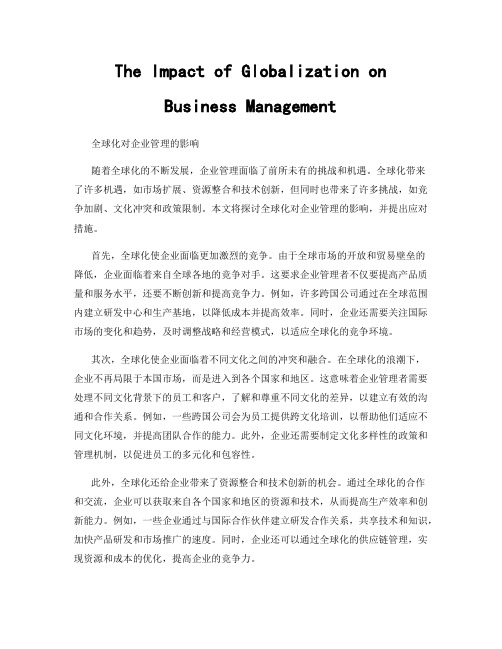
The Impact of Globalization onBusiness Management全球化对企业管理的影响随着全球化的不断发展,企业管理面临了前所未有的挑战和机遇。
全球化带来了许多机遇,如市场扩展、资源整合和技术创新,但同时也带来了许多挑战,如竞争加剧、文化冲突和政策限制。
本文将探讨全球化对企业管理的影响,并提出应对措施。
首先,全球化使企业面临更加激烈的竞争。
由于全球市场的开放和贸易壁垒的降低,企业面临着来自全球各地的竞争对手。
这要求企业管理者不仅要提高产品质量和服务水平,还要不断创新和提高竞争力。
例如,许多跨国公司通过在全球范围内建立研发中心和生产基地,以降低成本并提高效率。
同时,企业还需要关注国际市场的变化和趋势,及时调整战略和经营模式,以适应全球化的竞争环境。
其次,全球化使企业面临着不同文化之间的冲突和融合。
在全球化的浪潮下,企业不再局限于本国市场,而是进入到各个国家和地区。
这意味着企业管理者需要处理不同文化背景下的员工和客户,了解和尊重不同文化的差异,以建立有效的沟通和合作关系。
例如,一些跨国公司会为员工提供跨文化培训,以帮助他们适应不同文化环境,并提高团队合作的能力。
此外,企业还需要制定文化多样性的政策和管理机制,以促进员工的多元化和包容性。
此外,全球化还给企业带来了资源整合和技术创新的机会。
通过全球化的合作和交流,企业可以获取来自各个国家和地区的资源和技术,从而提高生产效率和创新能力。
例如,一些企业通过与国际合作伙伴建立研发合作关系,共享技术和知识,加快产品研发和市场推广的速度。
同时,企业还可以通过全球化的供应链管理,实现资源和成本的优化,提高企业的竞争力。
然而,全球化也带来了一些挑战,如政策限制和环境保护。
由于各国对于外国投资和贸易的限制不断增加,企业在跨国经营中面临着政策和法规的不确定性。
此外,全球化也加剧了环境问题,如气候变化和资源短缺。
企业管理者需要关注环境可持续发展的问题,采取创新的环保措施,以减少对环境的影响。
Impactforbusiness:对企业的影响
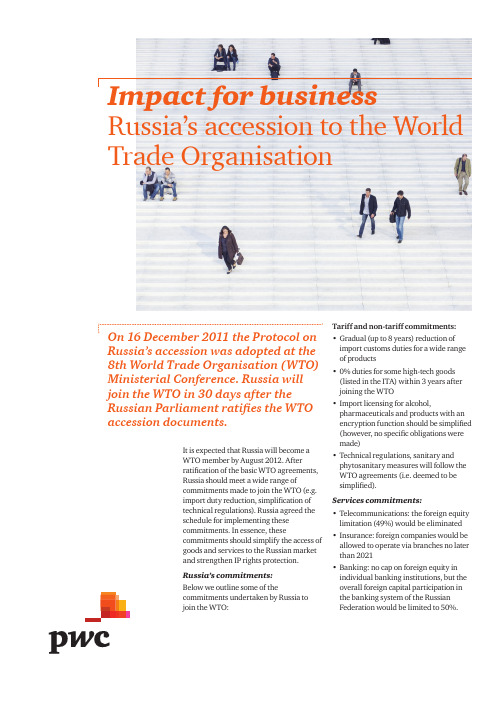
It is expected that Russia will become a WTO member by August 2012. After ratification of the basic WTO agreements, Russia should meet a wide range of commitments made to join the WTO (e.g. import duty reduction, simplification of technical regulations). Russia agreed the schedule for implementing these commitments. In essence, these commitments should simplify the access of goods and services to the Russian market and strengthen IP rights protection. Russia’s commitments:Below we outline some of the commitments undertaken by Russia to join the WTO:Tariff and non-tariff commitments:• Gradual (up to 8 years) reduction of import customs duties for a wide range of products• 0% duties for some high-tech goods (listed in the ITA) within 3 years after joining the WTO• Import licensing for alcohol, pharmaceuticals and products with an encryption function should be simplified (however, no specific obligations were made)• Technical regulations, sanitary and phytosanitary measures will follow the WTO agreements (i.e. deemed to be simplified).Services commitments:• Telecommunications: the foreign equity limitation (49%) would be eliminated • Insurance: foreign companies would be allowed to operate via branches no later than 2021• Banking: no cap on foreign equity in individual banking institutions, but the overall foreign capital participation in the banking system of the Russian Federation would be limited to 50%.Impact for business Russia’s accession to the World Trade OrganisationOn 16 December 2011 the Protocol onRussia’s accession was adopted at the8th World Trade Organisation (WTO)Ministerial Conference. Russia willjoin the WTO in 30 days after theRussian Parliament ratifies the WTOaccession documents.Intellectual property rights (IPR) protection:• Application of WTO Agreement on Trade-Related Aspects of Intellectual Property Rights.WTO benefits for RussiaGenerally speaking, few positive effects to Russia’s economy are expected from Russia’s WTO membership, namely:• Improvement of business and investment climate in Russia• Ability to use WTO rules and procedures governing the settlement of trade disputes to protect Russian exports to foreign markets Industry impactRussia’s WTO accession will have an impact on many industries in Russia. Please find below some examples of such impact for certain industries:AutomotiveReduction of import duty rates for light vehicles, trucks and buses (transition period is 7 years). Termination ofpreferential duty rates under “industrial assembly” agreements by 1 July 2018.FootwearReduction of duty rates for a range of shoes. For example, customs duty for footwear with outer soles of rubber,plastics, leather or composition leather will decline from EUR 10 (but not less than EUR 1 per pair) to EUR 0.34 per pair by 2015.ChemicalsReduction of duty rates for a range of chemical products. For example, customs duty for some plastic products will decline from 20% to 6.5% by 2017.AgricultureReduction of import duty rates for some agricultural products. For example, import duties for powder milk will decrease from 25% to 15% by 2015 or 2016, depending on the type of product.Agricultural equipmentReduction of customs duties for some types of agricultural machinery and equipment. For example, customs duties for combine harvesters will decline from 15% (but not less than EUR 120 per 1 kW of engine power) to 5% from the date of accession.Medical productsReduction of duty rates for some types of medical products. For example, customs duties for plastic syringes will decrease from 15% to 5% by 2017.Electrical equipmentReduction of duty rates for a range of electrical equipment. For example,customs duty for synchronous motors of an output not exceeding 18W will decrease from 15% to 10% by 2016.Alcohol and soft beveragesRussia did not make any duty or taxcommitments in respect of a reduction of duty rates for alcohol and soft beverages.ContactsAnne WilliamsDirectorCustoms and International Trade **********************.com +353 1 792 6528Paul RodgersSenior ManagerCustoms and International Trade *******************.com +353 1 792 6696John O’Loughlin ManagerCustoms and International Trade ***********************.com +353 1 792 6093Marina VolkovaDirector*********************.com +7 (495) 967 6223IrelandRussiaThis content is for general information purposes only, and should not be used as a substitute for consultation with professional advisors.© 2012 PricewaterhouseCoopers. All rights reserved. PwC refers to the Irish member firm, and may sometimes refer to the PwC network. Each member firm is a separate legal entity. Please see /structure for further details.PwC firms help organisations and individuals create the value they’re looking for. We’re a network of firms in 158 countries with close to 169,000 people who are committed to delivering quality in assurance, tax and advisory services. Tell us what matters to you and find out more by visiting us at . DS 04141The procedures for import licensing should be simplified.Consumer goodsReduction of import duties for a wide range of consumer goods. For example, customs duties forperfumes and toilet water will be reduced from 15% to 6.5% by 2016. Duty rates for washing machines will decrease from 15% to 10% by 2015.Information and Communication TechnologyReduction of import duty to 0% for products covered by the ITA (e.g. flat panel monitors, network equipment) by the middle of 2015 as compared to the current average import duty of 5%.。
The Impact of Automation on Employee Training
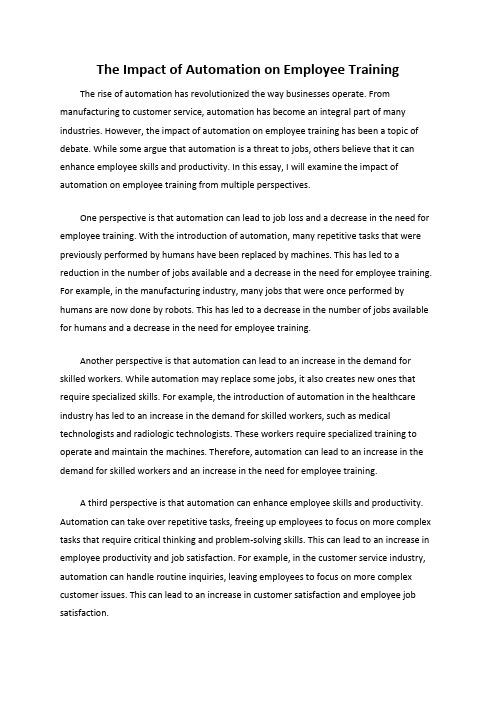
The Impact of Automation on Employee Training The rise of automation has revolutionized the way businesses operate. From manufacturing to customer service, automation has become an integral part of many industries. However, the impact of automation on employee training has been a topic of debate. While some argue that automation is a threat to jobs, others believe that it can enhance employee skills and productivity. In this essay, I will examine the impact of automation on employee training from multiple perspectives.One perspective is that automation can lead to job loss and a decrease in the need for employee training. With the introduction of automation, many repetitive tasks that were previously performed by humans have been replaced by machines. This has led to a reduction in the number of jobs available and a decrease in the need for employee training. For example, in the manufacturing industry, many jobs that were once performed by humans are now done by robots. This has led to a decrease in the number of jobs available for humans and a decrease in the need for employee training.Another perspective is that automation can lead to an increase in the demand for skilled workers. While automation may replace some jobs, it also creates new ones that require specialized skills. For example, the introduction of automation in the healthcare industry has led to an increase in the demand for skilled workers, such as medical technologists and radiologic technologists. These workers require specialized training to operate and maintain the machines. Therefore, automation can lead to an increase in the demand for skilled workers and an increase in the need for employee training.A third perspective is that automation can enhance employee skills and productivity. Automation can take over repetitive tasks, freeing up employees to focus on more complex tasks that require critical thinking and problem-solving skills. This can lead to an increase in employee productivity and job satisfaction. For example, in the customer service industry, automation can handle routine inquiries, leaving employees to focus on more complex customer issues. This can lead to an increase in customer satisfaction and employee job satisfaction.However, there are also concerns that automation can lead to a skills gap. As automation takes over repetitive tasks, employees may not have the opportunity to develop the skills needed for more complex tasks. This can lead to a skills gap where employees lack the skills needed for the new jobs created by automation. Therefore, it is important for employers to provide training opportunities for employees to develop the skills needed for the new jobs created by automation.In conclusion, the impact of automation on employee training is complex and multifaceted. While automation may lead to job loss and a decrease in the need for employee training in some industries, it can also create new jobs that require specialized skills and enhance employee skills and productivity in others. Therefore, it is important for employers to carefully consider the impact of automation on employee training and provide training opportunities for employees to develop the skills needed for the new jobs created by automation.。
气候变化对商业影响的雅思作文
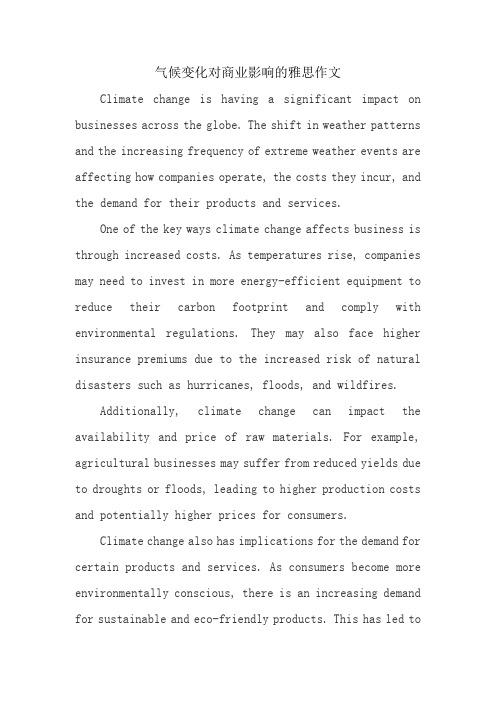
气候变化对商业影响的雅思作文Climate change is having a significant impact on businesses across the globe. The shift in weather patterns and the increasing frequency of extreme weather events are affecting how companies operate, the costs they incur, and the demand for their products and services.One of the key ways climate change affects business is through increased costs. As temperatures rise, companies may need to invest in more energy-efficient equipment to reduce their carbon footprint and comply with environmental regulations. They may also face higher insurance premiums due to the increased risk of natural disasters such as hurricanes, floods, and wildfires.Additionally, climate change can impact the availability and price of raw materials. For example, agricultural businesses may suffer from reduced yields due to droughts or floods, leading to higher production costs and potentially higher prices for consumers.Climate change also has implications for the demand for certain products and services. As consumers become more environmentally conscious, there is an increasing demand for sustainable and eco-friendly products. This has led tothe emergence of new markets and opportunities for businesses that can innovate and adapt to meet these demands.Furthermore, climate change can affect the productivity and health of employees. Heatwaves and poor air quality can lead to increased absenteeism and lower productivity in the workplace. This not only affects the bottom line but also impacts the company's reputation if it is perceived as not prioritizing the well-being of its employees.In conclusion, climate change is a pressing issue that businesses cannot afford to ignore. It is important for companies to understand the potential impacts and take steps to mitigate them. This may involve investing in sustainable practices, adapting to new market demands, and prioritizing the health and well-being of their employees. By doing so, businesses can not only minimize their negative impact on the environment but also position themselves to thrive in a rapidly changing world.中文翻译:气候变化正在对全球范围内的企业产生重大影响。
The Impact of AI on Business
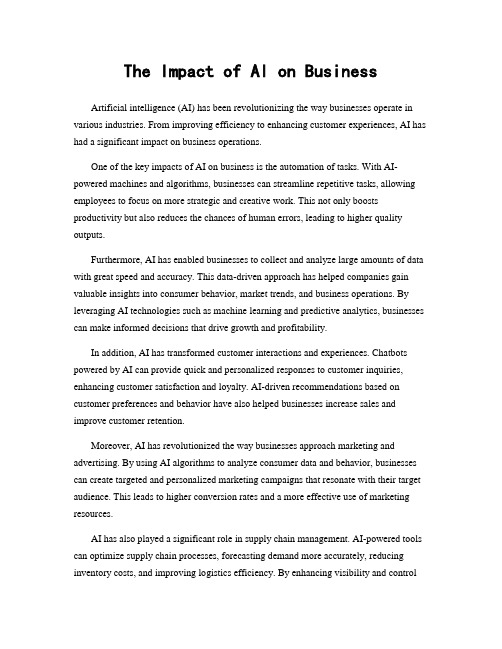
The Impact of AI on BusinessArtificial intelligence (AI) has been revolutionizing the way businesses operate in various industries. From improving efficiency to enhancing customer experiences, AI has had a significant impact on business operations.One of the key impacts of AI on business is the automation of tasks. With AI-powered machines and algorithms, businesses can streamline repetitive tasks, allowing employees to focus on more strategic and creative work. This not only boosts productivity but also reduces the chances of human errors, leading to higher quality outputs.Furthermore, AI has enabled businesses to collect and analyze large amounts of data with great speed and accuracy. This data-driven approach has helped companies gain valuable insights into consumer behavior, market trends, and business operations. By leveraging AI technologies such as machine learning and predictive analytics, businesses can make informed decisions that drive growth and profitability.In addition, AI has transformed customer interactions and experiences. Chatbots powered by AI can provide quick and personalized responses to customer inquiries, enhancing customer satisfaction and loyalty. AI-driven recommendations based on customer preferences and behavior have also helped businesses increase sales and improve customer retention.Moreover, AI has revolutionized the way businesses approach marketing and advertising. By using AI algorithms to analyze consumer data and behavior, businesses can create targeted and personalized marketing campaigns that resonate with their target audience. This leads to higher conversion rates and a more effective use of marketing resources.AI has also played a significant role in supply chain management. AI-powered tools can optimize supply chain processes, forecasting demand more accurately, reducing inventory costs, and improving logistics efficiency. By enhancing visibility and controlover the supply chain, businesses can minimize disruptions and improve overall operational performance.Furthermore, AI has enabled businesses to enhance cybersecurity measures. AI technologies can detect and respond to cybersecurity threats in real-time, helping businesses mitigate risks and protect sensitive data. With the increasing frequency of cyber attacks, AI-powered cybersecurity solutions have become crucial for businesses to safeguard their digital assets and maintain trust with customers.Overall, the impact of AI on business has been profound, reshaping business processes, improving decision-making, and enhancing customer experiences. As AI technologies continue to advance, businesses that embrace AI will gain a competitive edge in the marketplace and drive growth in the digital age.。
Impacts of Globalization on Local Economies
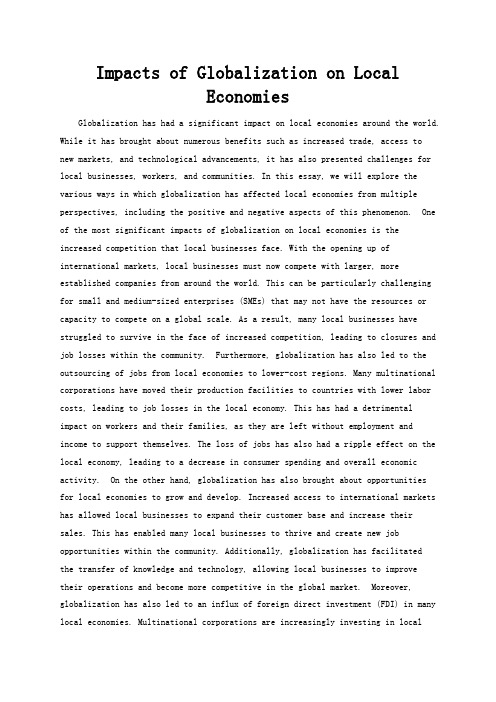
Impacts of Globalization on LocalEconomiesGlobalization has had a significant impact on local economies around the world. While it has brought about numerous benefits such as increased trade, access to new markets, and technological advancements, it has also presented challenges for local businesses, workers, and communities. In this essay, we will explore the various ways in which globalization has affected local economies from multiple perspectives, including the positive and negative aspects of this phenomenon. One of the most significant impacts of globalization on local economies is the increased competition that local businesses face. With the opening up of international markets, local businesses must now compete with larger, more established companies from around the world. This can be particularly challenging for small and medium-sized enterprises (SMEs) that may not have the resources or capacity to compete on a global scale. As a result, many local businesses have struggled to survive in the face of increased competition, leading to closures and job losses within the community. Furthermore, globalization has also led to the outsourcing of jobs from local economies to lower-cost regions. Many multinational corporations have moved their production facilities to countries with lower labor costs, leading to job losses in the local economy. This has had a detrimental impact on workers and their families, as they are left without employment and income to support themselves. The loss of jobs has also had a ripple effect on the local economy, leading to a decrease in consumer spending and overall economic activity. On the other hand, globalization has also brought about opportunitiesfor local economies to grow and develop. Increased access to international markets has allowed local businesses to expand their customer base and increase their sales. This has enabled many local businesses to thrive and create new job opportunities within the community. Additionally, globalization has facilitatedthe transfer of knowledge and technology, allowing local businesses to improvetheir operations and become more competitive in the global market. Moreover, globalization has also led to an influx of foreign direct investment (FDI) in many local economies. Multinational corporations are increasingly investing in localbusinesses and industries, bringing in new capital, technology, and expertise. This has helped to stimulate economic growth and development in many local economies, creating new opportunities for employment and innovation. Additionally, FDI has also helped to improve infrastructure and create new industries, further contributing to the overall development of the local economy. However, it is important to acknowledge that globalization has also led to the homogenization of cultures and the loss of local traditions and practices. As international brands and products become more prevalent in local markets, there is a risk of local cultures and traditions being overshadowed or even replaced by globalized trends. This can have a negative impact on the identity and heritage of local communities, as they may struggle to preserve their unique cultural identity in the face of globalization. In conclusion, the impacts of globalization on local economies are multifaceted, encompassing both positive and negative aspects. While globalization has brought about increased competition and job losses for local businesses and workers, it has also presented opportunities for growth, development, and innovation. It is important for local economies to adapt and embrace the opportunities presented by globalization, while also taking steps to mitigate the challenges and protect their unique cultural identity. Ultimately, a balanced approach that leverages the benefits of globalization while addressing its challenges is essential for the sustainable development of local economies in the globalized world.。
保护地球英语作文

Protecting our planet is a responsibility that each of us shares.Here are some key points to consider when writing an essay on the importance of safeguarding Earth:1.Introduction to the Importance of Earth:Begin by emphasizing the significance of Earth as the only known planet that supports life.Mention the unique ecosystems and biodiversity that make our planet habitable.2.Current Environmental Challenges:Discuss the various environmental issues that Earth is facing today,such as climate change,deforestation,pollution,and loss of biodiversity.Provide statistics or examples to illustrate the severity of these problems.3.Consequences of Inaction:Explain the potential consequences if we fail to protect the environment.This could include more frequent natural disasters,food and water scarcity, and the extinction of species.4.Individual Actions:Highlight the small steps individuals can take to contribute to environmental protection.This may include reducing waste,conserving energy,recycling, and supporting sustainable products.munity and Government Initiatives:Discuss largerscale efforts such as community cleanups,government policies to reduce emissions,and international agreements to combat climate change.6.Technological Advancements:Mention the role of technology in environmental protection,such as renewable energy sources,electric vehicles,and innovations in waste management.cation and Awareness:Stress the importance of educating the public about environmental issues and promoting awareness.This can lead to behavioral changes and support for environmental policies.8.The Role of Businesses:Businesses have a significant impact on the environment. Discuss how companies can adopt sustainable practices,reduce their carbon footprint, and contribute to a greener economy.9.Global Cooperation:Emphasize the need for international cooperation in addressing environmental challenges.No single country can tackle these issues alone,and global solidarity is crucial.10.Conclusion:Conclude by reiterating the urgency of protecting Earth and thecollective effort required.Encourage readers to take action and contribute to the preservation of our planet.Remember to use persuasive language and logical arguments to convince your readers of the importance of environmental protection.Provide a balanced view by discussing both the problems and the potential solutions.。
ACCA 财务管理 (14)

6 Government assistance for business P50•6.1 Official aid schemes•The freedom of European governments to offer cash grants and other forms of direct assistance to business is limited by European Union policies designed toprevent the distortion of free market competition.•Government incentives might be offered on:•(a) A regional basis•(b) A selective national basis7 Green policies (P51)•There are a number of policy approaches topollution, such as polluter pays policies, subsidiesand direct legislation•7.1 Pollution policy•Externalities are positive or negative effects on third parties resulting from production and consumption activities.7.2 Legislation (P51)•To impose legislation laying down regulations governing waste disposal and atmospheric emissions.7.3 Advantages of “environmentally friendly policies ” for a business•P51•(a) More inclined to buy its products•(b) Enhance relationships with the public in general orwith local communities.•(c) People may prefer to work for environmentallyfriendly business•(d) “Ethical ” investment funds may be more likely tobuy the firm’s shares8 Corporate governance regulation P51•The corporate governance debate impacts upon the way companies make decisions, their financial organisation and their relations with investor and auditors.•8.1 Impact of corporate governance requirements on businesses (P52)•The consequences of failure to obey•Financial penalties, bad publicity•Impact on share prices, extra costs。
